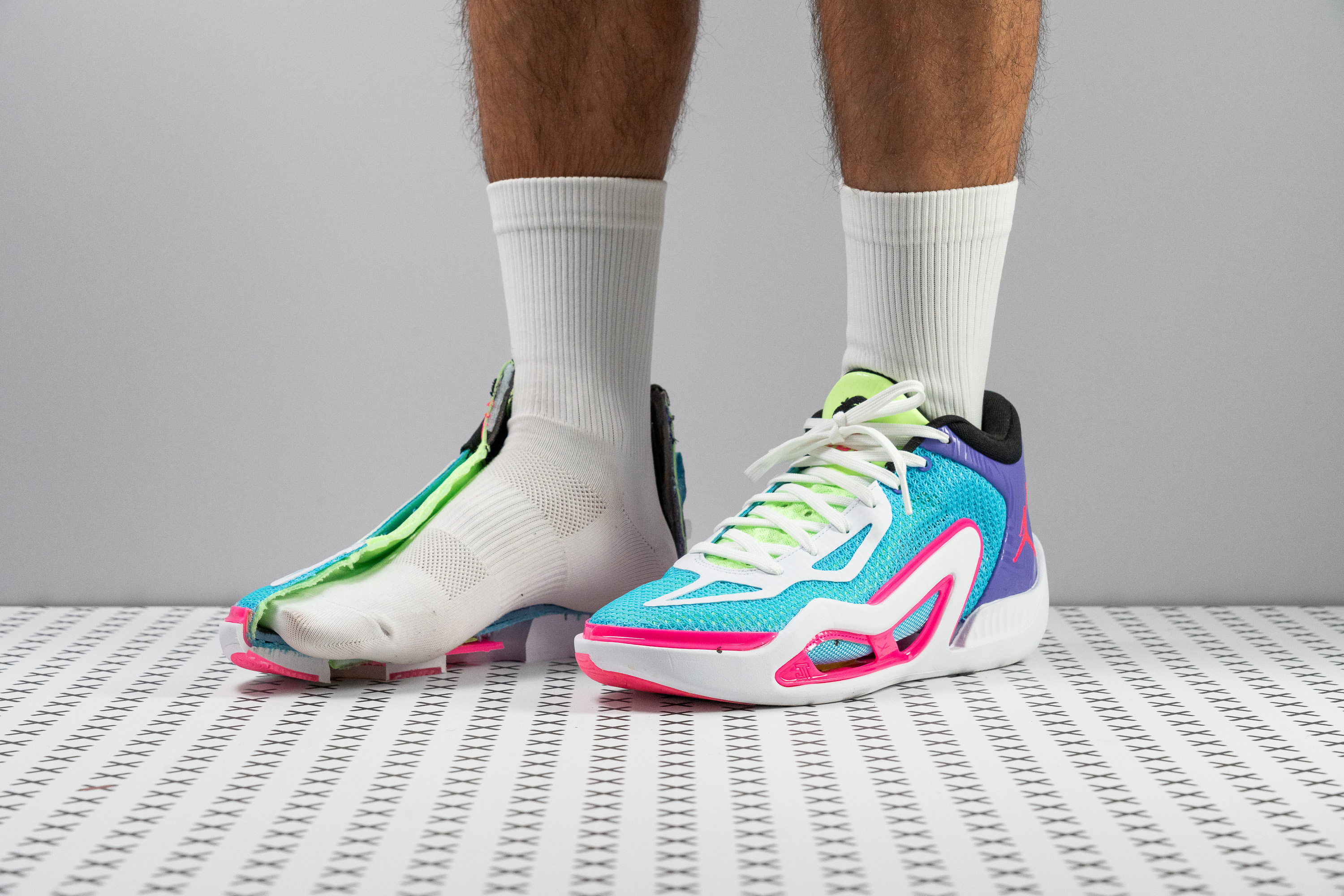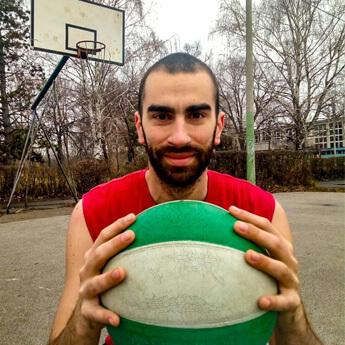Our verdict
Pros
- Durable and grippy forefoot rubber
- Quite lightweight structure
- Definitely a lot of court feel
- Bouncy forefoot
- Durability and breathability balance
- Truly a bang for the buck
- Eye-catching style
Cons
- Not very stable
- Rearfoot lacks grip and durability
- Not for outdoor use
Audience verdict
Comparison
The most similar basketball shoes compared
+ + Add a shoe | |||||
|---|---|---|---|---|---|
| Audience score | 83 Good! | 88 Great! | 88 Great! | 71 Bad! | |
| Price | £120 | £120 | £70 | £120 | |
| Signature | Jayson Tatum | Jayson Tatum | - | - | |
| Shock absorption | - | Low | - | - | |
| Energy return | - | Low | - | - | |
| Traction | - | Low | - | - | |
| Top | Mid | Low | Mid | Mid | |
| Ankle support | ✗ | ✓ | ✗ | ✓ | |
| Weight lab | 11.6 oz / 329g | 12.4 oz / 352g | 13.1 oz / 371g | 13.1 oz / 372g | |
| Lightweight | ✓ | ✓ | ✓ | ✓ | |
| Breathability | Moderate | Warm | Moderate | Moderate | |
| Outsole durability | Good | Good | - | - | |
| Drop lab | 6.1 mm | 7.8 mm | 7.1 mm | 8.9 mm | |
| Heel stack lab | 28.0 mm | 24.8 mm | 29.0 mm | 29.0 mm | |
| Forefoot | 21.9 mm | 17.0 mm | 21.9 mm | 20.1 mm | |
| Size | True to size | True to size | Slightly small | Slightly small | |
| Midsole softness | Balanced | Soft | Firm | Firm | |
| Stiffness | Stiff | Moderate | Stiff | Stiff | |
| Torsional rigidity | Flexible | Moderate | Flexible | Moderate | |
| Heel counter stiffness | Flexible | Flexible | Flexible | Moderate | |
| Width / fit | Medium | Narrow | Narrow | Narrow | |
| Toebox width | Wide | Medium | Wide | Medium | |
| Midsole width - forefoot | Average | Narrow | Average | Narrow | |
| Midsole width - heel | Narrow | Narrow | Average | Average | |
| Heel padding durability | Decent | Decent | Decent | Bad | |
| Toebox durability | Decent | Decent | Decent | - | |
| Insole thickness | Average | Average | Average | Average | |
| Outsole hardness | Very soft | - | Average | Soft | |
| Outsole thickness | Average | Average | Average | Thick | |
| Heel tab | Finger loop | None | Finger loop | None | |
| Ranking | #74 Bottom 15% | #21 Top 40% | #23 Top 44% | #53 Bottom 1% | |
| Popularity | #56 Bottom 36% | #23 Top 44% | #41 Bottom 22% | #49 Bottom 7% |
Who should buy
Jay Tatum fans, this is your call! The first model of your favourite hooper is here! Even if you're not a fan, we believe you should get this shoe if:
- You're looking for something lightweight with loads of court feel.
- You're a quick-feet player who loves fakes (ball fakes, crossover steps, or any kind).
- You're looking for an affordable model to play indoors.
- You want to look your best whilst you hoop.
- A bouncy forefoot is all you need.
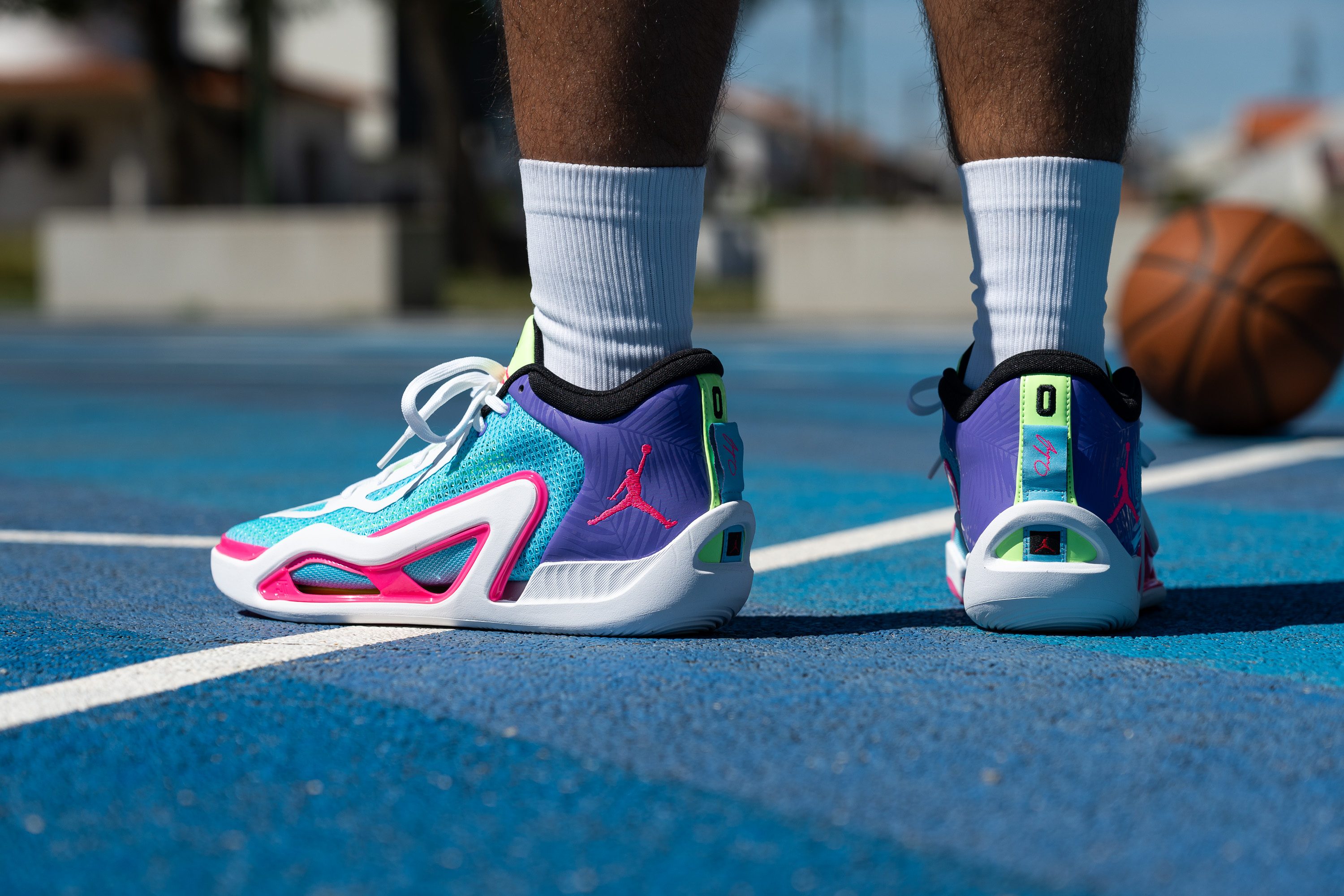
Who should not buy
Affordable shoes usually have to give up some features to keep their price low. You'd normally think this model decided to use less quality materials, but that wasn't the case. Nevertheless, we found its overall structure to be quite wobbly. If you don't want to be worrying about unsteady landings, you should have a look at the Jordan Luka 2. This model offers great support and grip, we definitely felt surefooted during our wear tests!
If streetball is your thing, these Jordans are a no-no. Trust us, the white material wouldn't last a week of aggressive playing. Also, you'd need some more stability for that! If you don't mind changing brands, then you might want to try the Adidas Dame 8. Just try to avoid dusty courts if possible!
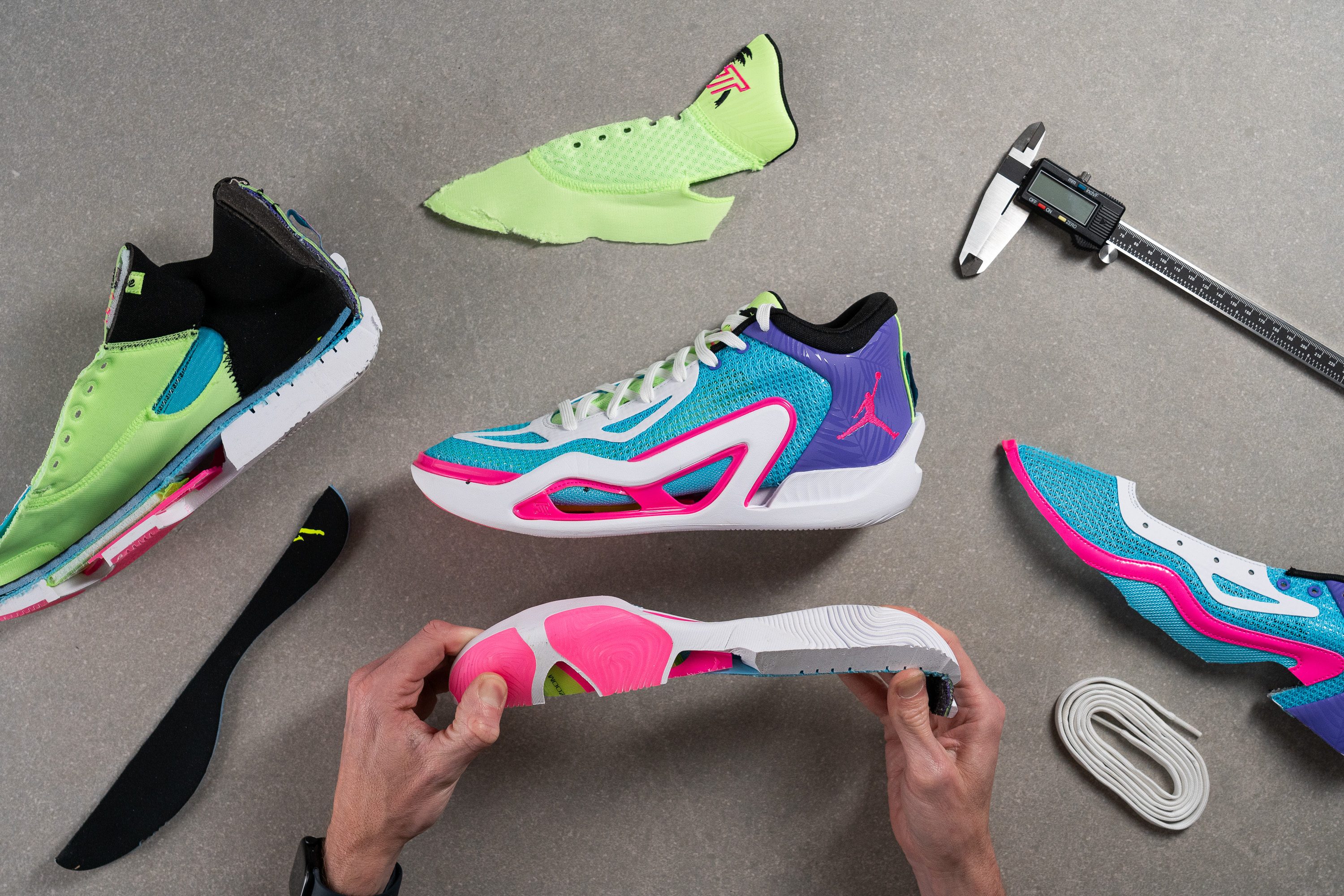
Cushioning
Heel stack
At 28.0 mm, these Jordans' heel stack is pretty close to the average.
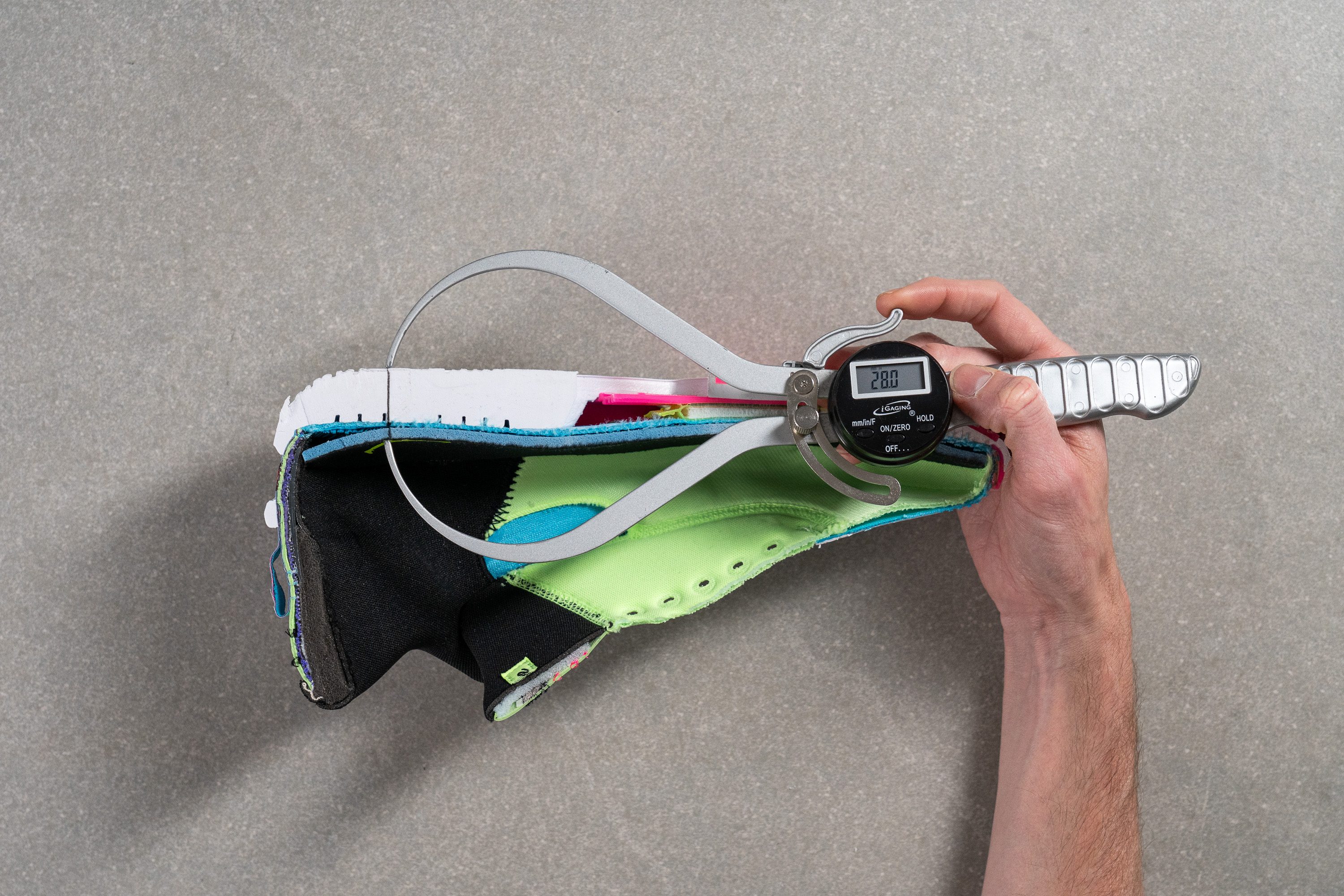
Normally, we would just say here what our feet felt: close contact to the court, more controlled moves, easier and more precise dribbles. But we need to mention that, as stated previously, this shoe doesn't have any rubber pods at the heel. This means that the material is less durable, which would be compensated if there was more of it, but... with a lower-than-average heel stack, it's definitely not the case.

If you're looking for an affordable option but you want it to be more durable overall, including a harder rubber in the outsole, we believe you should have a look at the Under Armour Lockdown 6.
| Tatum 1 | 28.0 mm |
| Average | 28.8 mm |
Forefoot stack
According to our durometer, at 21.9 mm the forefoot stack is just average.
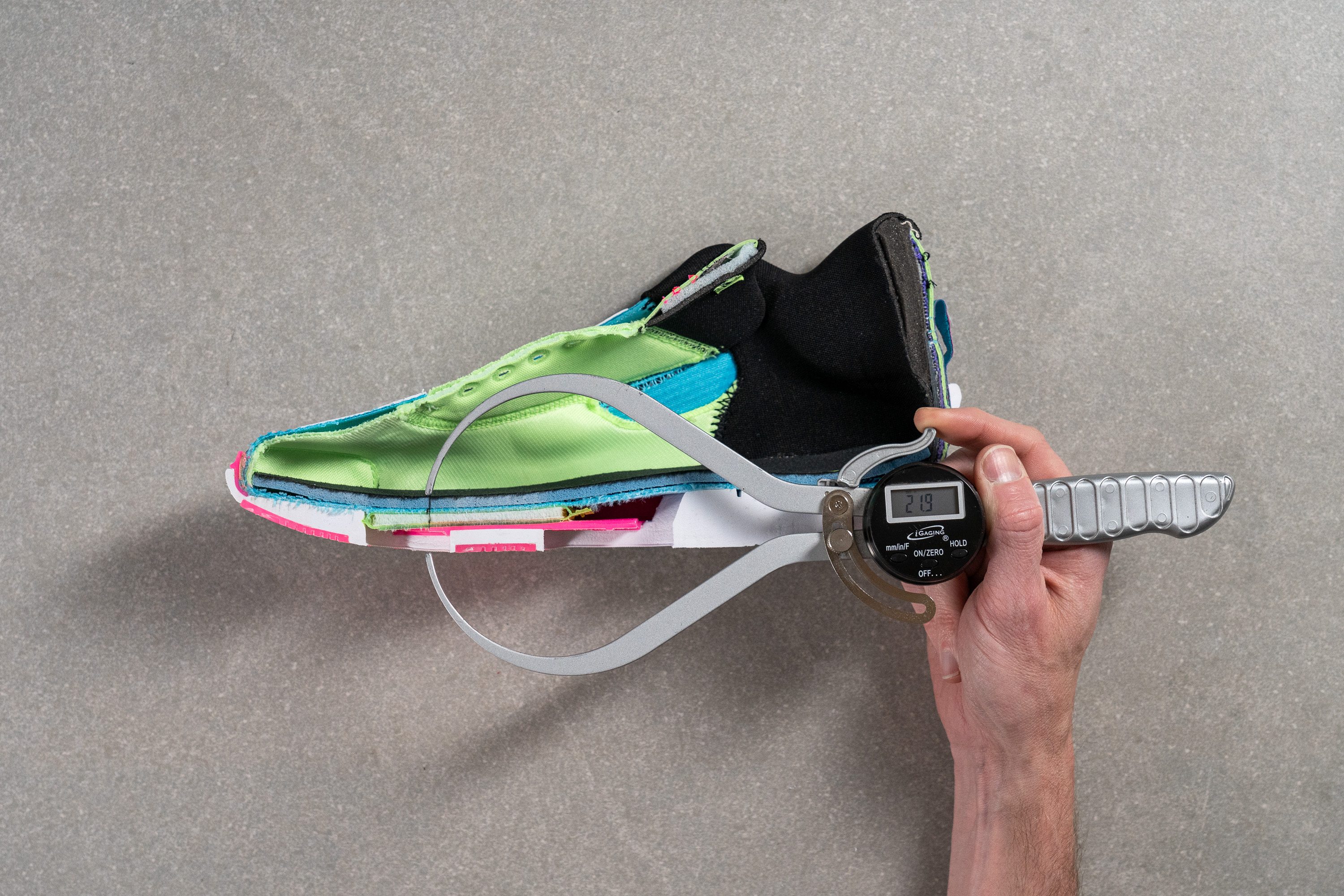
After our measurements, you can most likely tell that we're not talking about an extra cushioned shoe designed for centres. Just like Jayson Tatum himself, this model is made for forwards with a quick and aggressive playstyle. The court closeness that this shoe's low profile brings is what let us move around in the blink of an eye. It also made sure it was possible for our feet to follow our quick decisions, as sometimes you need to react at the speed of light when you're on the court.
Following Tatum's steps (quite literally) his shoe lets you go for your best attacks, but also for your finest defence. The player himself has a very important role in his team's defensive strategy, and this could never be possible for a forward if his shoes dragged him down along the court.
| Tatum 1 | 21.9 mm |
| Average | 21.4 mm |
Drop
The forefoot and heel stacks didn't have that big of a difference. At 6.1 mm, this shoe's drop is average.

You can see it clearly in the picture of our cut-in-half shoe. The heel is slightly higher, aiming for impact protection, yet the forefoot and its rubber pods are closer to the ground.
We found this combination fantastic for crossover steps. It was not only the low stack that helped us control our moves. The rubber pods at the forefoot also made sure our feet stopped right where they should in our fakes. Slipping would totally ruin the jab step.
| Tatum 1 | 6.1 mm |
| Average | 7.4 mm |
Midsole softness
At 27.3 HA, our durometer had it clear: this shoe's midsole softness is quite close to the average.
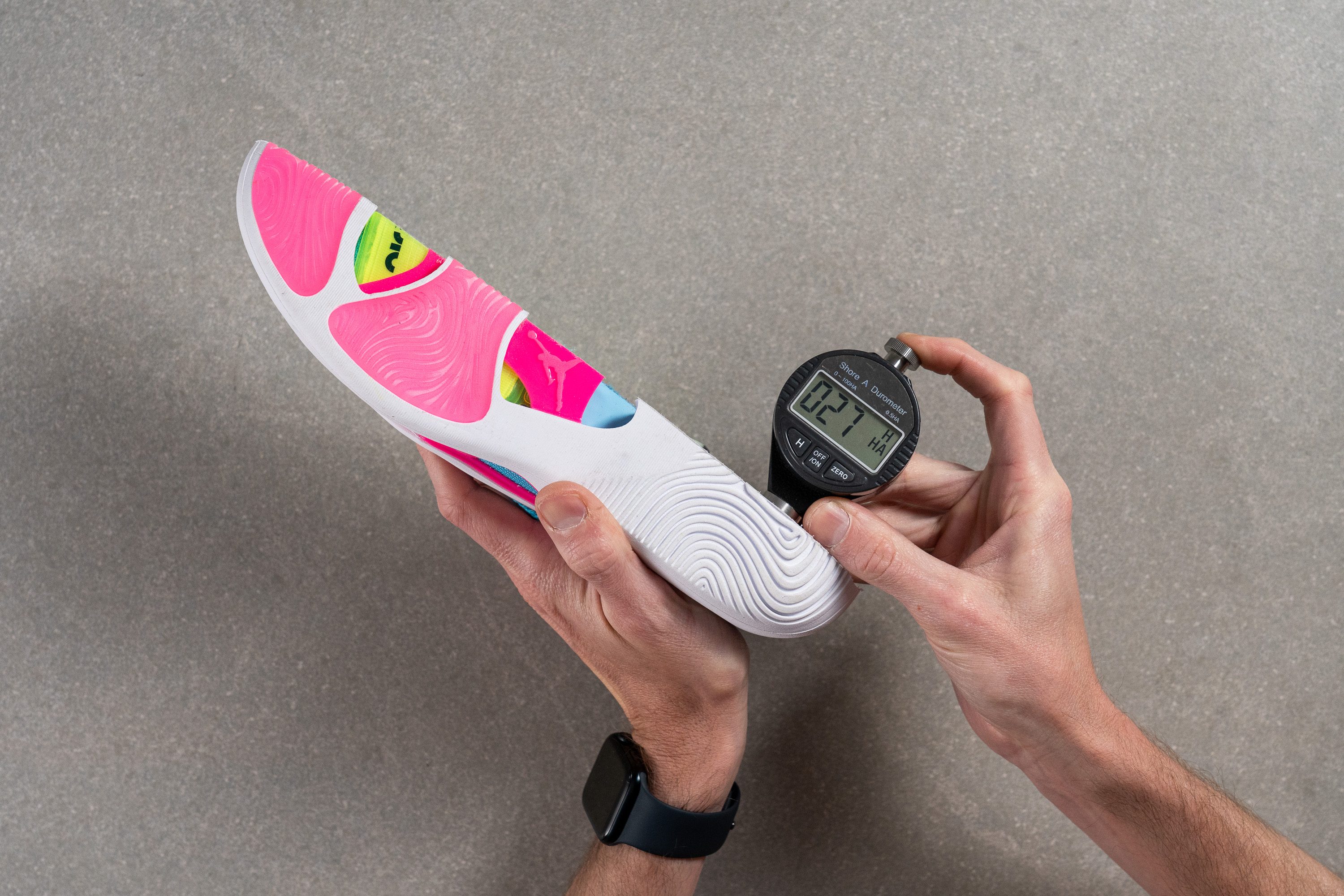
We can't say this shoe is the most comfortable hooper we've tried. Its rearfoot offers some impact protection, but we don't believe focuses on that. It doesn't have any specific technologies in that area, so it's more like these Jordan's outsole and you against the court.
Just by looking at this video we can clearly see the difference. This shoe's Zoom Air unit protects the forefoot, yet the rearfoot is left with nothing. The softness level and the bounce of the materials is not just easily noticed in the video, but also in our feet during our playtests.
If you're looking for an affordable and comfy pal, we believe you should have a look at the Nike Precision 6.
| Tatum 1 | 27.3 HA |
| Average | 24.3 HA |
Size and fit
Size
Jordan Tatum 1 fits true to size (20 votes).
Width / Fit
The toebox width at the widest part was, once again, average.
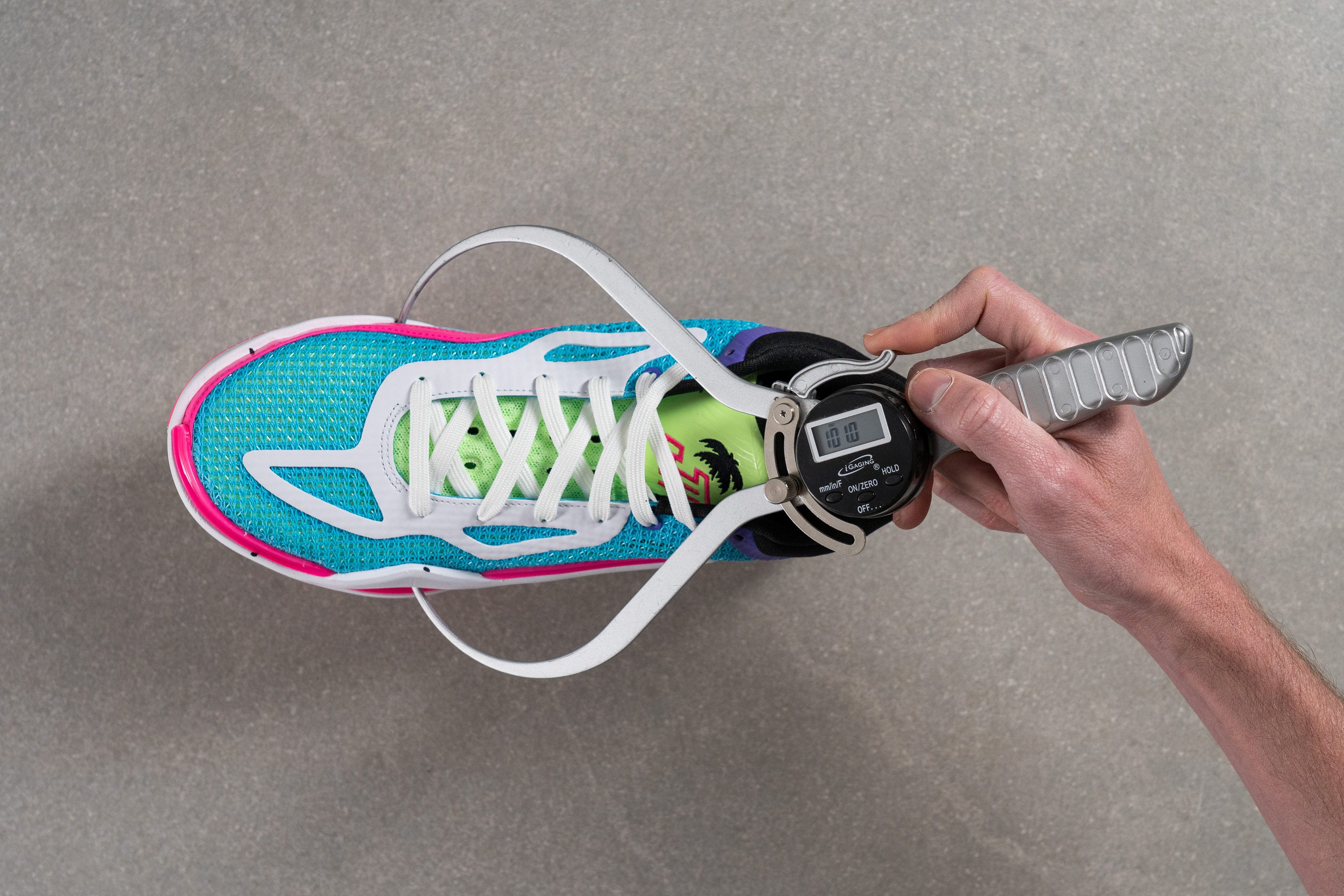
At 101.0 mm, our standard-width feet felt alright. We didn't have any issues, but following our calliper's measurement, we can't recommend this shoe to wide-feet hoopers.
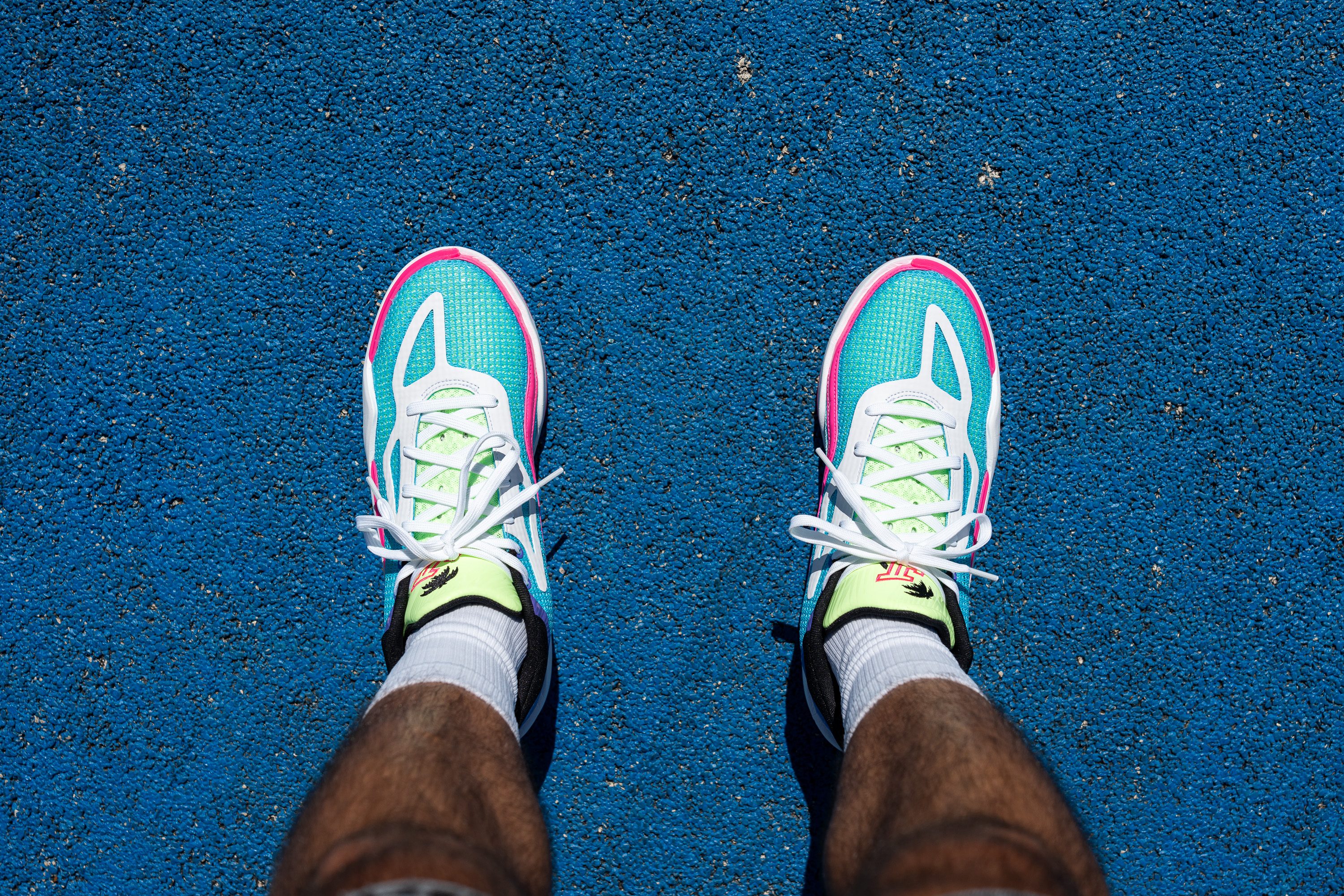
This test follows an older methodology, which is why you don't see recently tested shoes in the chart. Results from different methodologies can not be compared.
| Tatum 1 | 101.0 mm |
| Average | 101.6 mm |
Toebox width
At 78.5 mm, the Tatum 1's toebox width at the big toe is pretty close to the average.
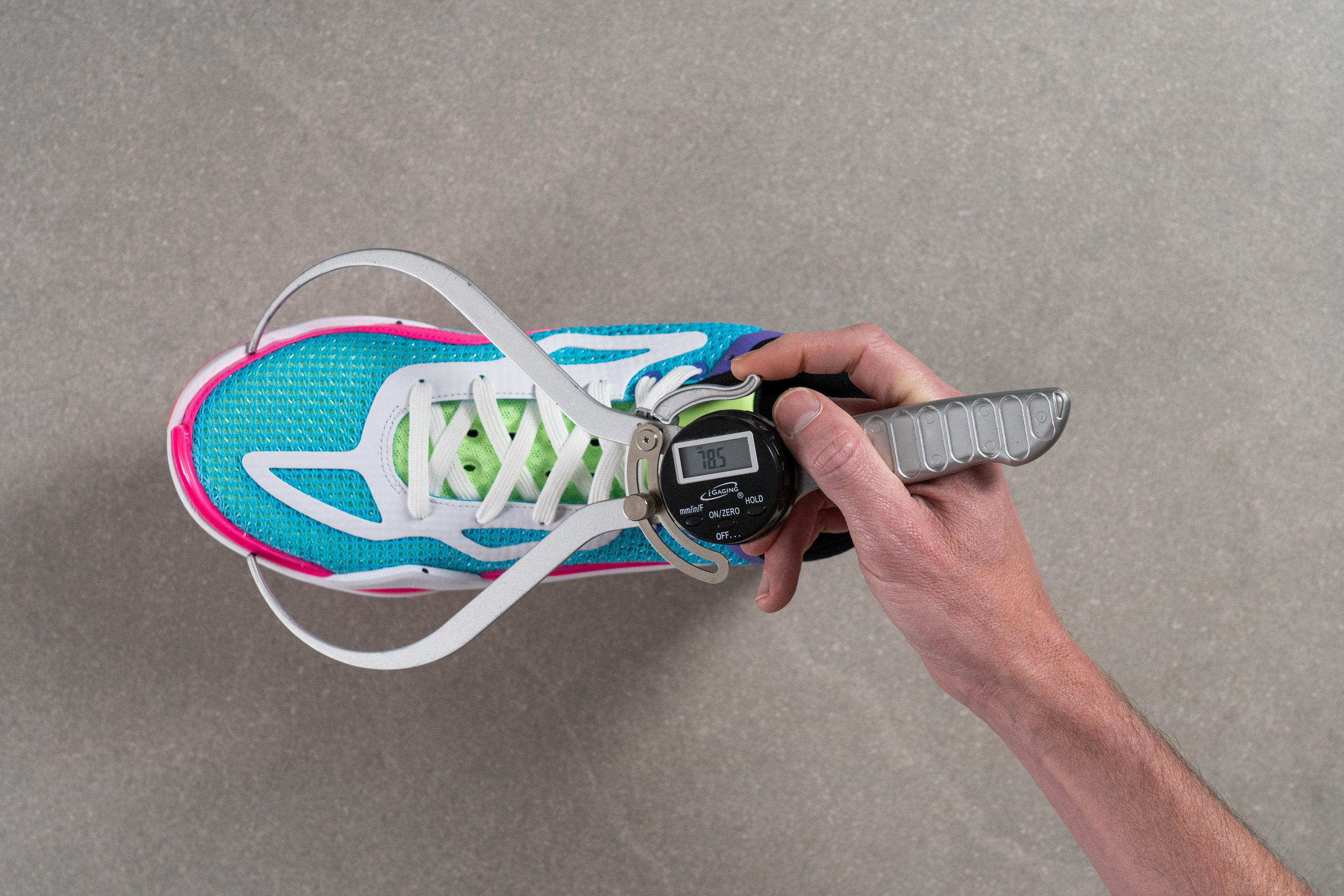
Our toes didn't get any extra room, but our standard-width feet didn't really mind it. The shoe's structure has a protective layer on the edge, yet the blue mesh is not extremely rigid.
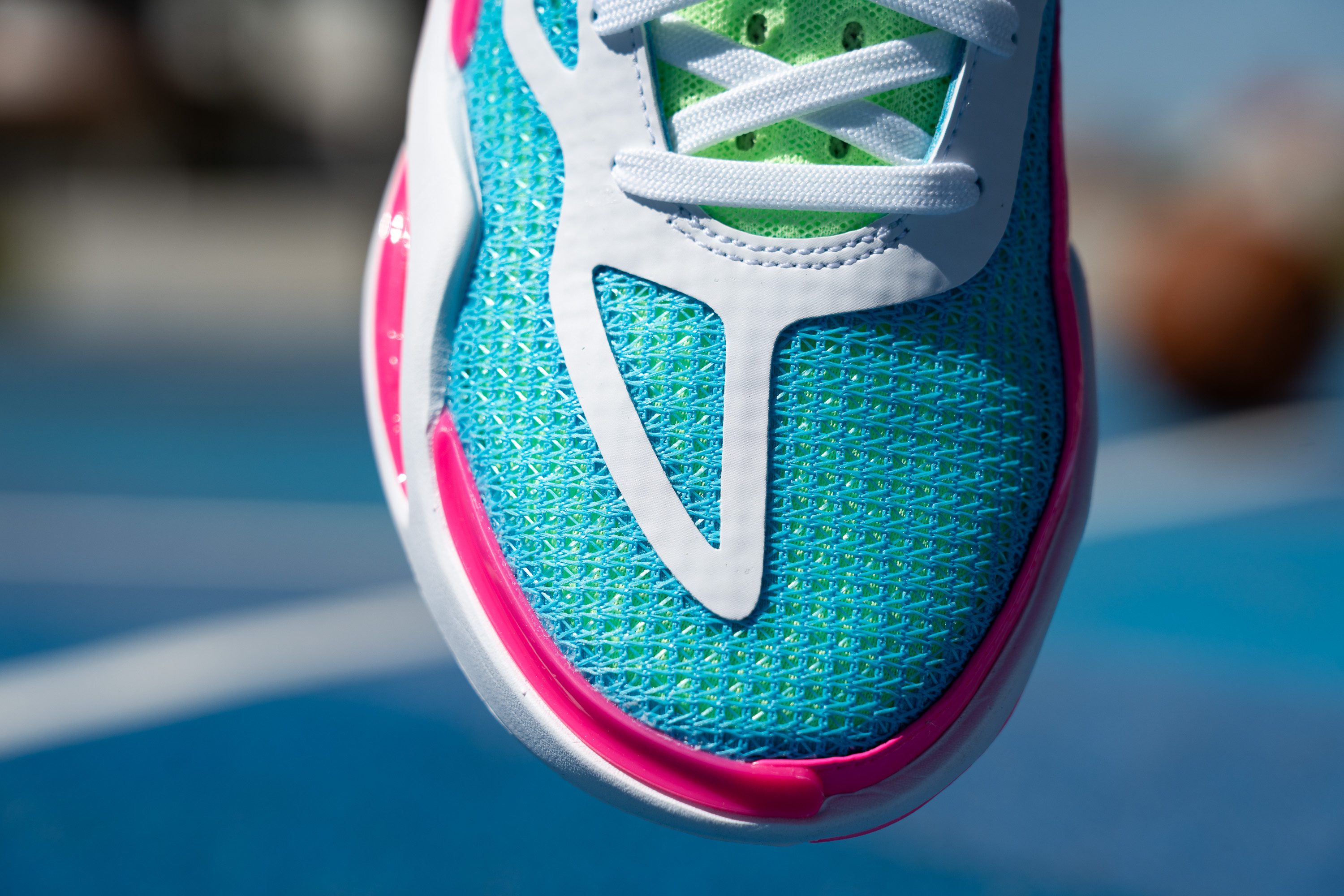
This allowed us to bend our feet easily, which is something we appreciated when we just wanted to put these hoopers on and go play some ball straight away.
This test follows an older methodology, which is why you don't see recently tested shoes in the chart. Results from different methodologies can not be compared.
| Tatum 1 | 78.5 mm |
| Average | 76.9 mm |
Flexibility / Stiffness
Despite what its big white TPU outside wings might tell you when you look at them, this shoe's structure is not the most supportive. It was not hard to make it bend with our hands in our torsional rigidity test, and our feet had the same experience.

To know a little bit more about its flexibility, we grabbed our gauge and checked how much force was needed for this shoe to reach a 90-degree position.
At 33.3N, it accompanied our moves smoothly. This meant that our heel-to-toe transitions were delightful, but that's not all. We also found this flexibility great to practice our shooting mechanics. In such exercises, it's important to be aware of the whole foot movement, especially the bending of such at the ball.
This test follows an older methodology, which is why you don't see recently tested shoes in the chart. Results from different methodologies can not be compared.
| Tatum 1 | 33.3N |
| Average | 38.8N |
Weight
During our playtests, we felt agile and ready to change directions at any moment thanks to the Tatum 1's light nature. Even before taking it to our lab, our feet could already tell that this model is ideal to move around the court swiftly.
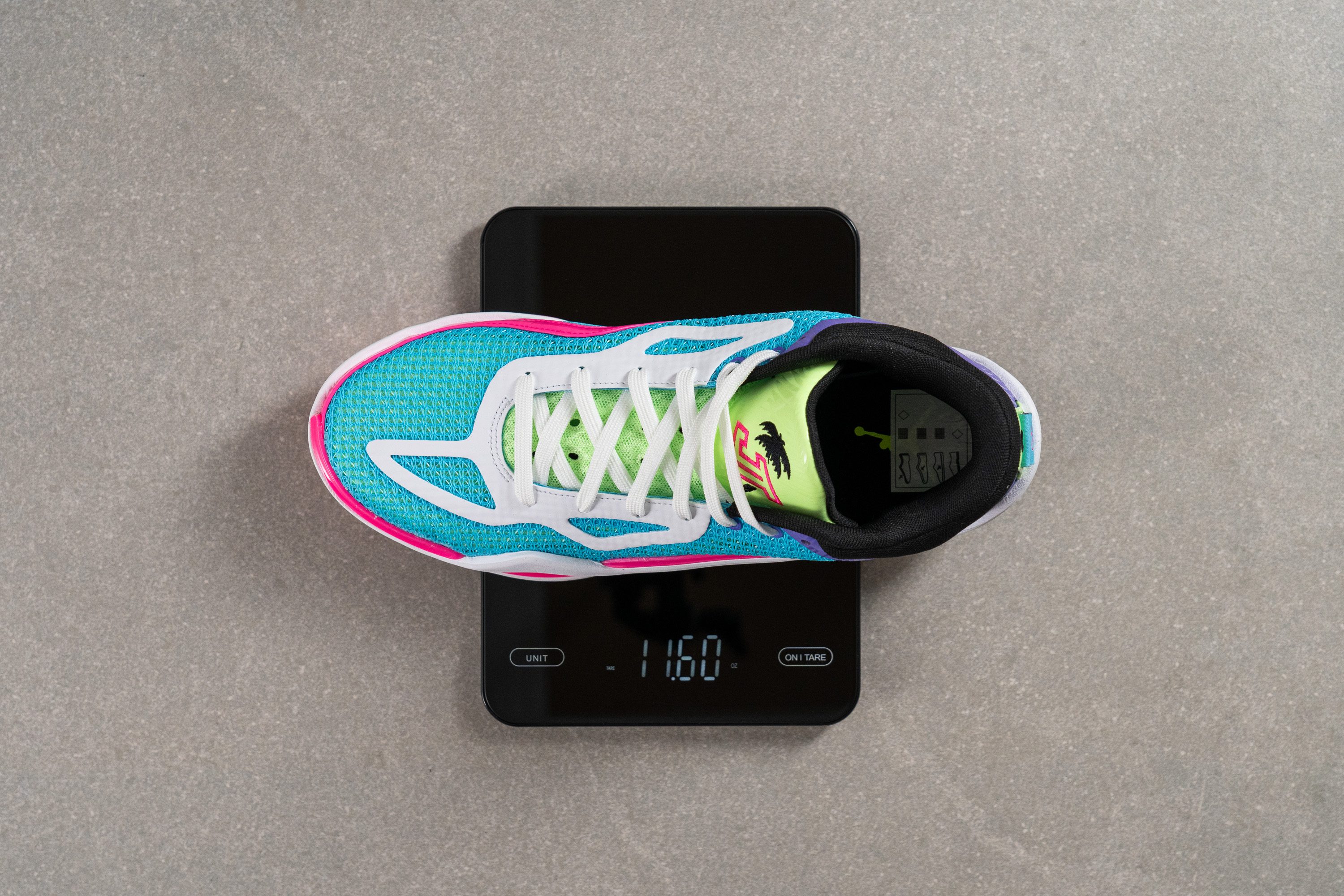
At 11.6 oz / 329.0g, these Jordans are way lighter than average, which is a feature that we absolutely love.
Running, walking, or going for a defensive balance when the opposing team gets the ball and you need to sprint across the court were never a drag for us. This shoe worked as a tool instead of an obstacle, helping us reach the attackers quickly and effectively. Don't let the NBA and its impressive plays fool you, having a good defence is just as important as being a good attacker when you play ball!
| Tatum 1 | 11.6 oz (329g) |
| Average | 13.8 oz (391g) |
Breathability
Breathability is a key point regarding footwear: be it running, hiking, walking, or anything in between! No matter what, we always make sure we study each model's ventilation.
In order to carry these tests out in the lab, we use our smoke machine, our microscope, and our light. Let's get started, then! Smoke machine, we choose you!
Not bad... not bad at all! As you can see in the video, there's a constant flow of smoke throughout the whole tongue. If you pay close attention, you can see a little bit of it coming out of the toebox too, which is great news! Compared to the Reebok Shaq Attaq, which scored a 1/5 in breathability, the 3/5 of these Jordans sounds like music to our ears.
This is most likely because of the upper's material, so let's dive into that. Microscope, we choose you!
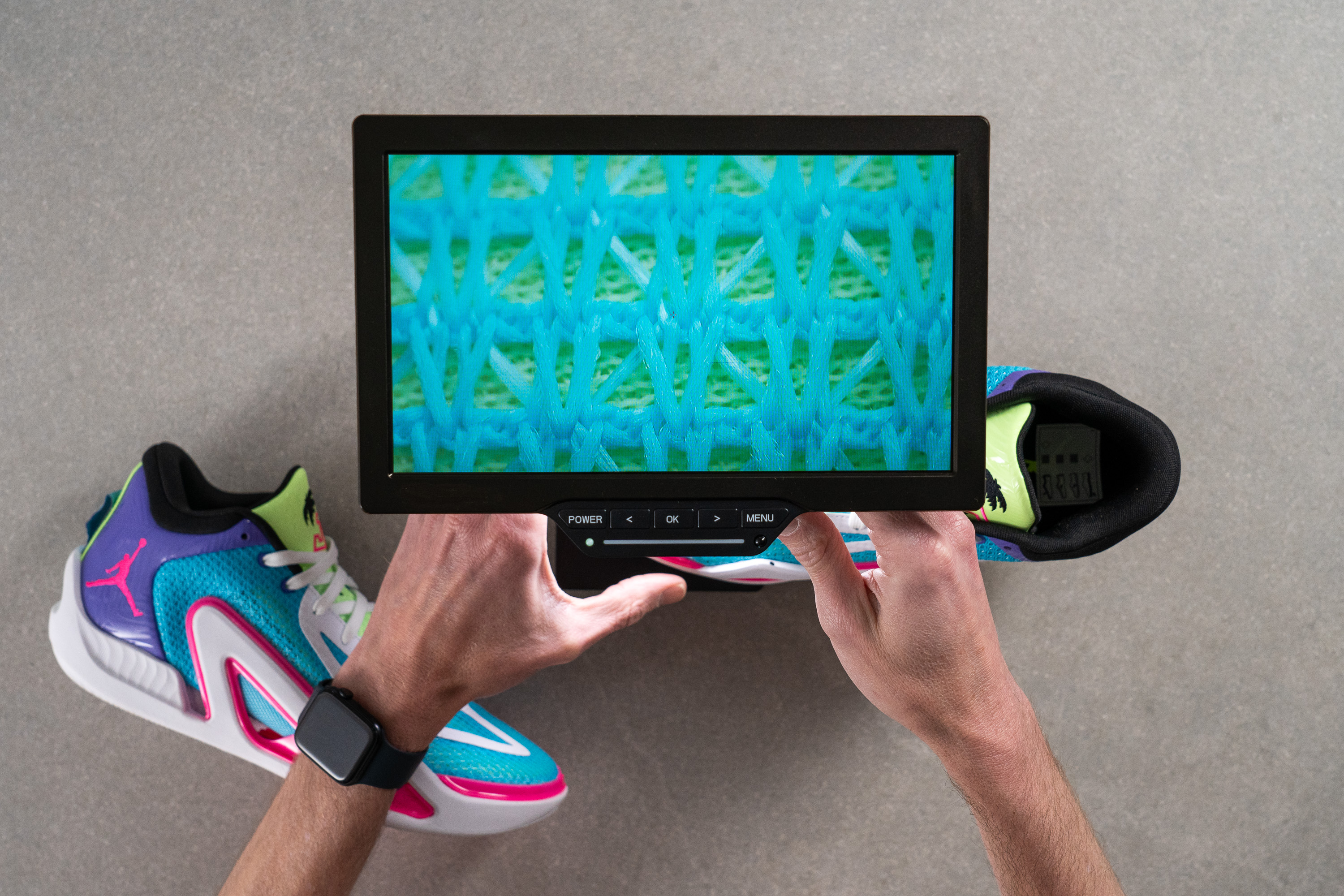
We can clearly see two layers in the picture: a blue one and a green one. The outer one has big gaps which would definitely allow plenty of airflow; nevertheless, the inner one is tightly woven. That's why the smoke had such a hard time coming out of the shoe.
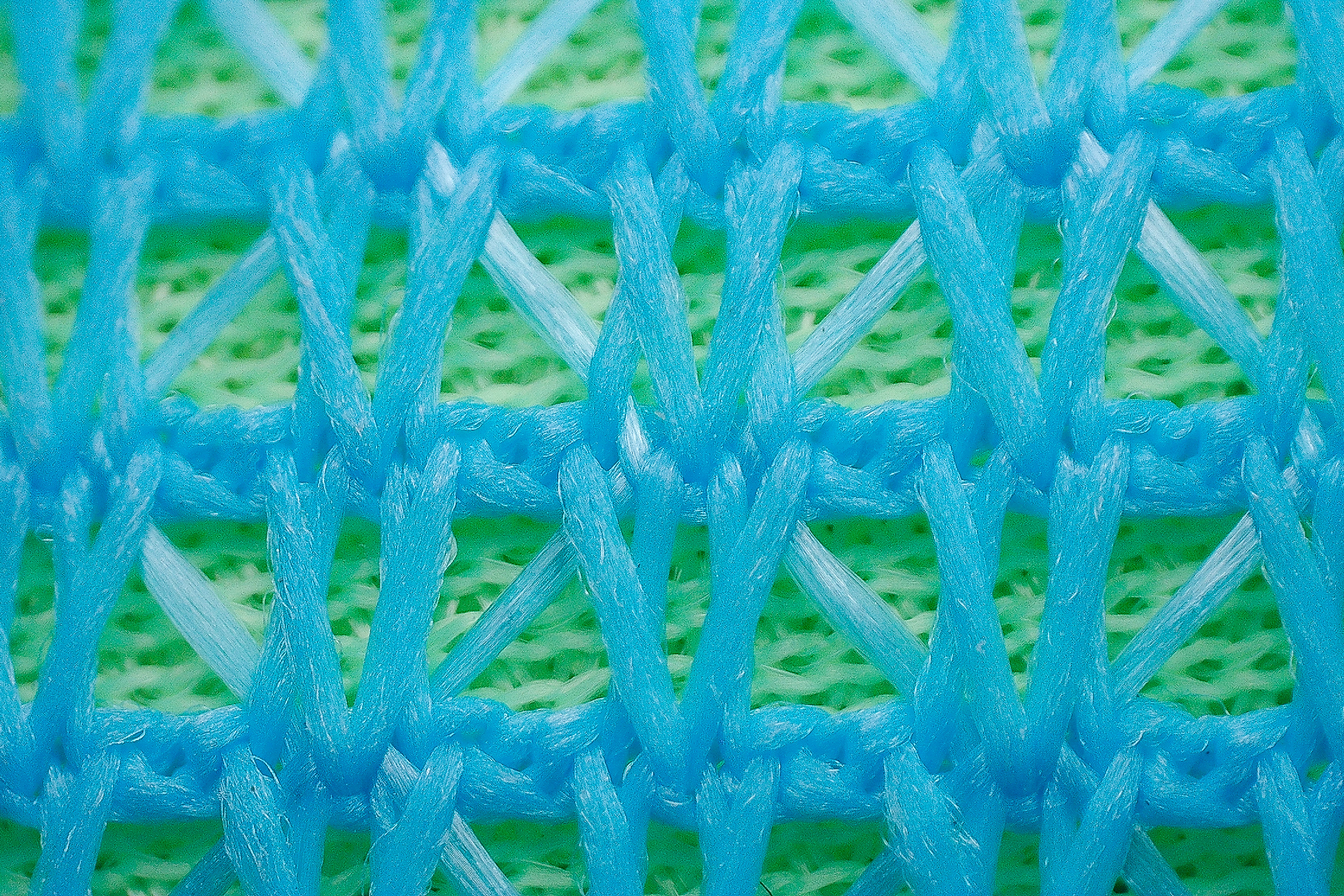
Wow, wait a second! There seems to be yet at least another layer under the first green one we saw in the previous picture. This is definitely the brand's doing in order to improve durability, and we love it!
We love using different tools to study every aspect of each shoe. In this case, we could see how the light happily went through the upper's woven material. Even though there are multiple layers, this explains why this model has got a better score at breathability compared to the average.
We trust in the multiple-layer armour to perform nicely on our durability tests, too. Let's check it out!
| Tatum 1 | 3 |
| Average | 2.5 |
Stability
Lateral stability test
Remember we were praising this shoe before because of its lightweight nature? Well, this comes at the expense of stability.
You can see in the video that our ankles don't move much, which is thanks to the padded structure and leather piece this shoe has at the back. Wait, we'll show it to you with a video.
So our ankles didn't really feel unsafe, but our foot itself... well, that's another story. You can see in the video how the underfoot moves even if we're just swaying our ankles.
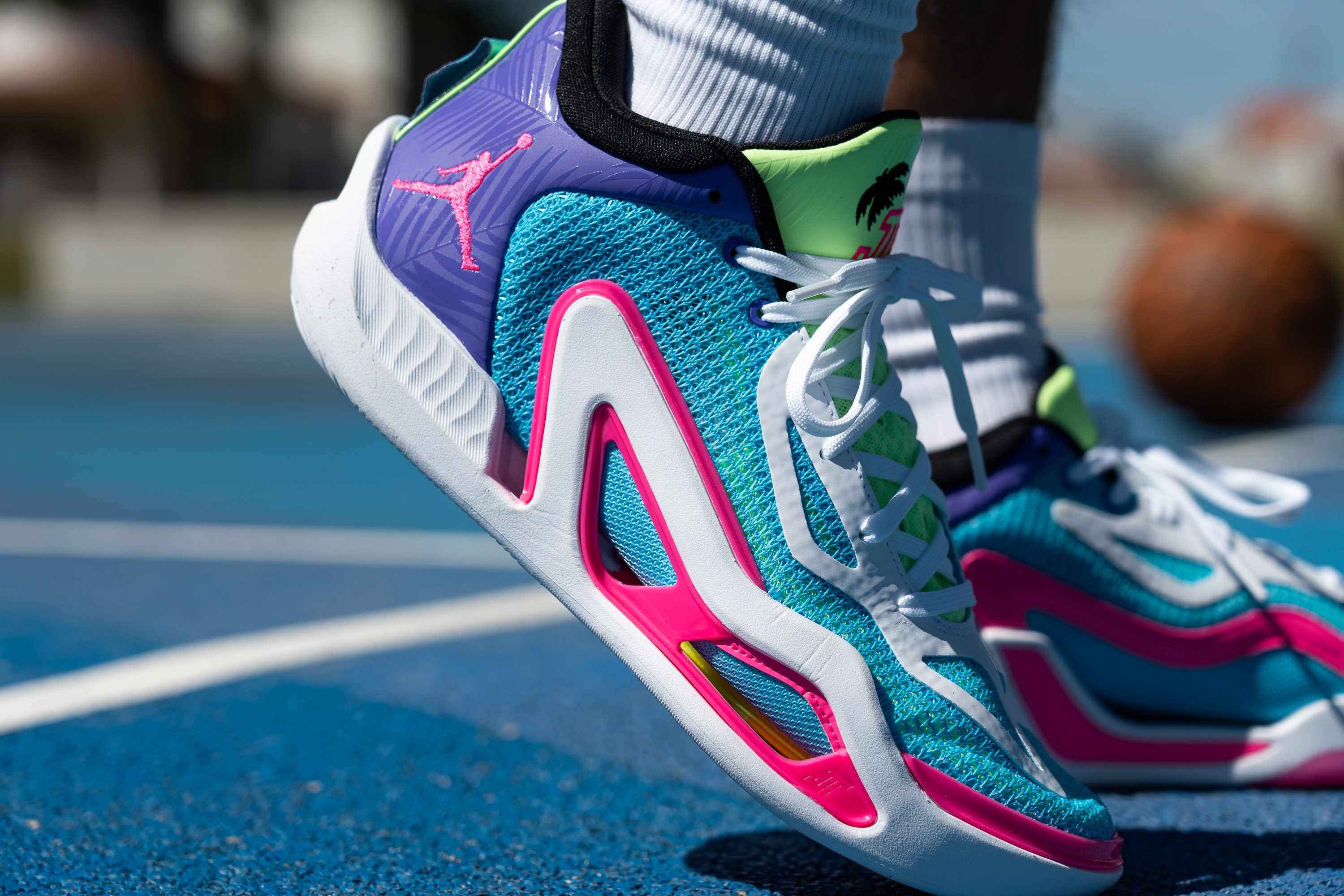
The forefoot was fine, yet the mid and rearfoot didn't feel that great to us. We could feel the lack of arch support, and the fact that this model is designed for Tatum himself, focusing on the forefoot with the snappiness of its Zoom Air Unit because of his playstyle, which means the shoe's design doesn't revolve around the heel.
We caught it in this video. Can you see how the rearfoot slips when we go for a backdoor cut? It's subtle, but to us this is game-changing.
Consequently, we believe you should go little by little with these hoopers. Try them out if you have the chance (even better if it's on a clean court) and see how you feel with them. Don't go for crazy jumping moves against other people (such as rebounds where you unavoidably hit other players most of the time) right off the bat. Give the shoe and your feet some time to test its stability.
It was definitely not the best for us, so please be careful!
Torsional rigidity
A 3/5 in our torsional rigidity test is an average score in many categories. But in basketball? Nuh-uh, getting less than a 4 in this aspect might be dangerous.
As you can see, the shoe bends quite easily with our hands, which means it's less stable. It's got two big outer wings that surround the midfoot. This piece was what initially gave us hope, but in our torsional rigidity test and wear tests, we found out it was not supportive enough.
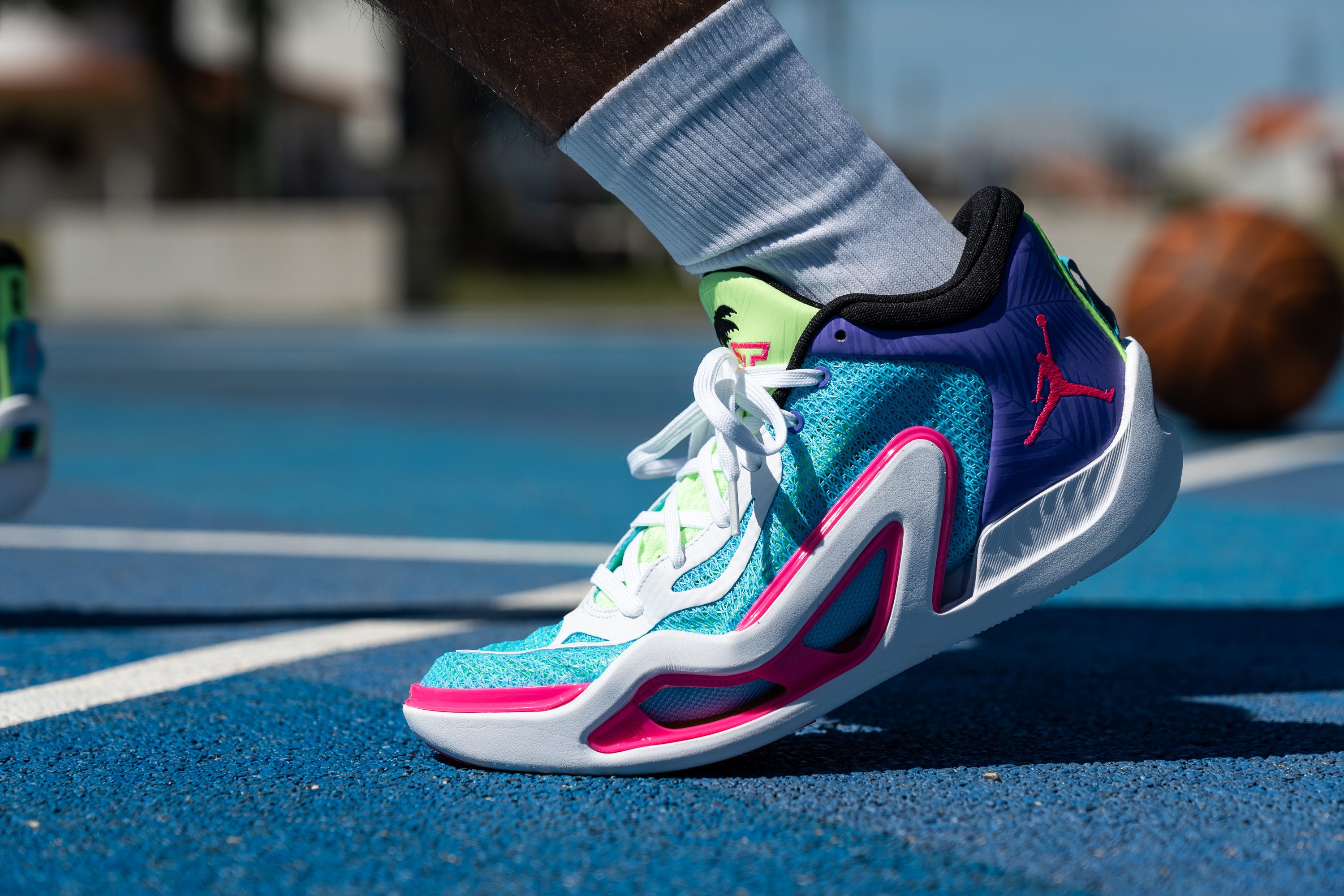
The shoe bent with our hands and feet pretty easily, and this piece didn't stop it. Also, if you pay close attention to the sides, you can see there's a gap, which definitely didn't help regarding stability.
| Tatum 1 | 3 |
| Average | 4.5 |
Heel counter stiffness
A 3/5 in our heel counter stiffness test was not a result that different from what we expected.
The shoe's leather material surrounding our ankles definitely added some support. We didn't have to deal with heel slippage and our ankles felt okay. Not great, but safe enough for us not to be constantly checking them.
| Tatum 1 | 3 |
| Average | 3.8 |
Midsole width - forefoot
Its midsole width in the forefoot is close to the average, just slightly narrower. At 113.3 mm, our calliper confirmed what our mid-sized feet felt: a nice fit.
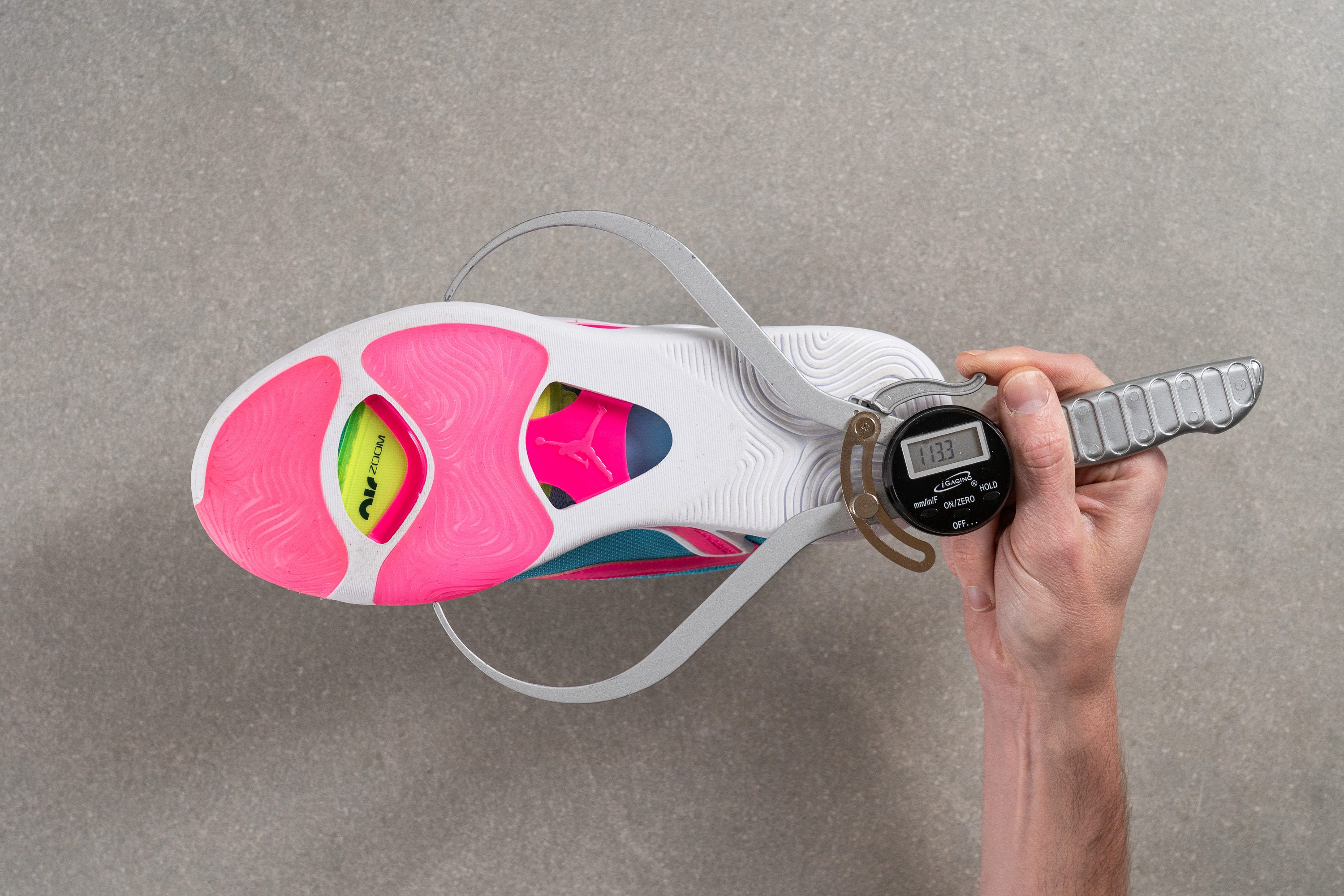
| Tatum 1 | 113.3 mm |
| Average | 114.8 mm |
Midsole width - heel
Most likely to add some support, the brand went for a snugger fit in the ankle. At 83.1 mm, our calliper explained why we didn't have any heel slippage problems.
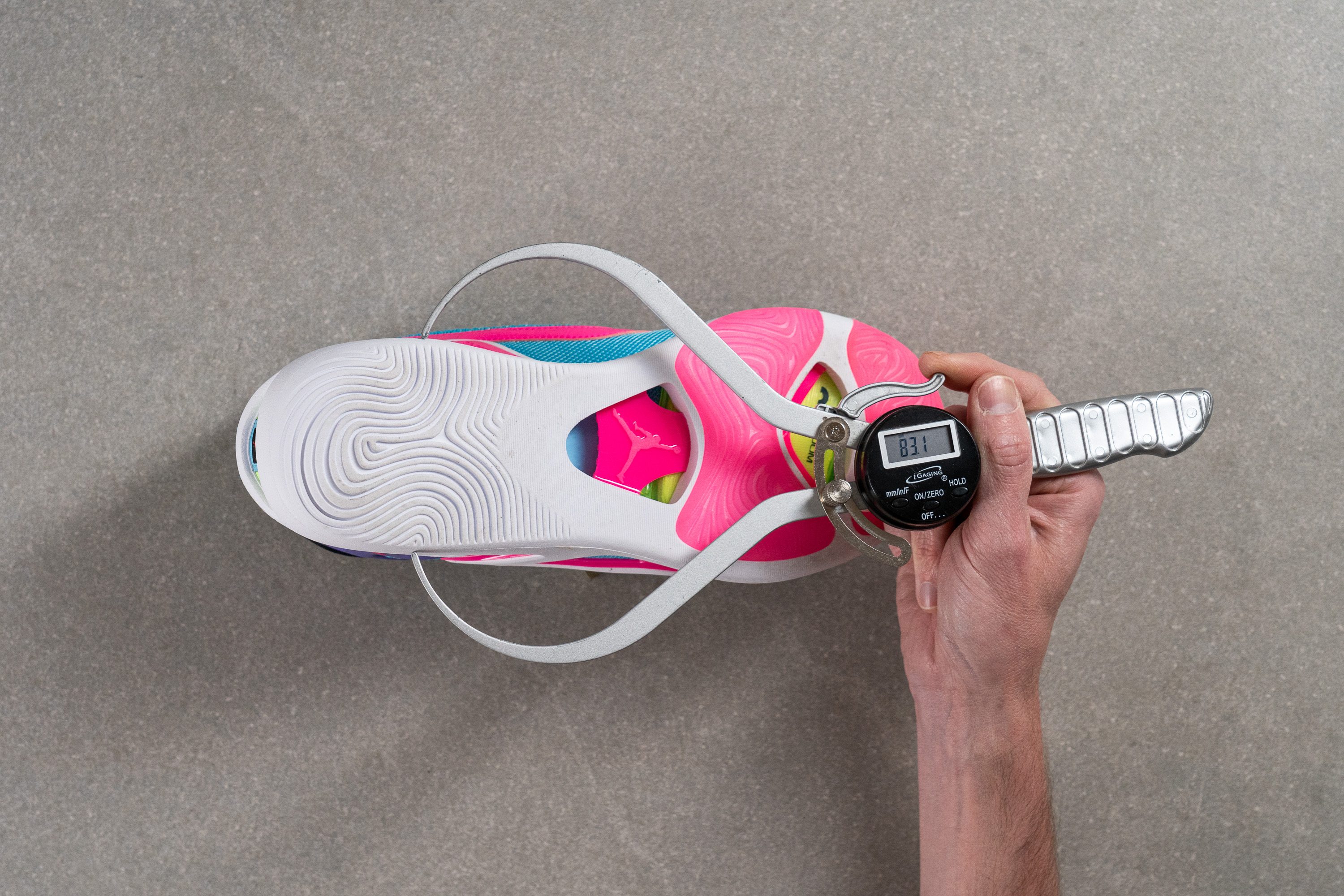
| Tatum 1 | 83.1 mm |
| Average | 89.7 mm |
Durability
Toebox durability
Time to test this pair's durability: Dremel, we choose you!
Let us tell you a little bit about this test. It lasts 12 seconds, and our tool goes at the speed of 10K RPM at 3.2N. We always put the rolling tip in the exact same spot. This helps us when we want to compare different shoes, as we keep the coherence in our tests. In this very specific case, we also slightly moved our Dremel away from the white layer.
Why? Well, because that white overlayer that works as this shoe's protection is not all around the toebox. It's more like a tough detail!
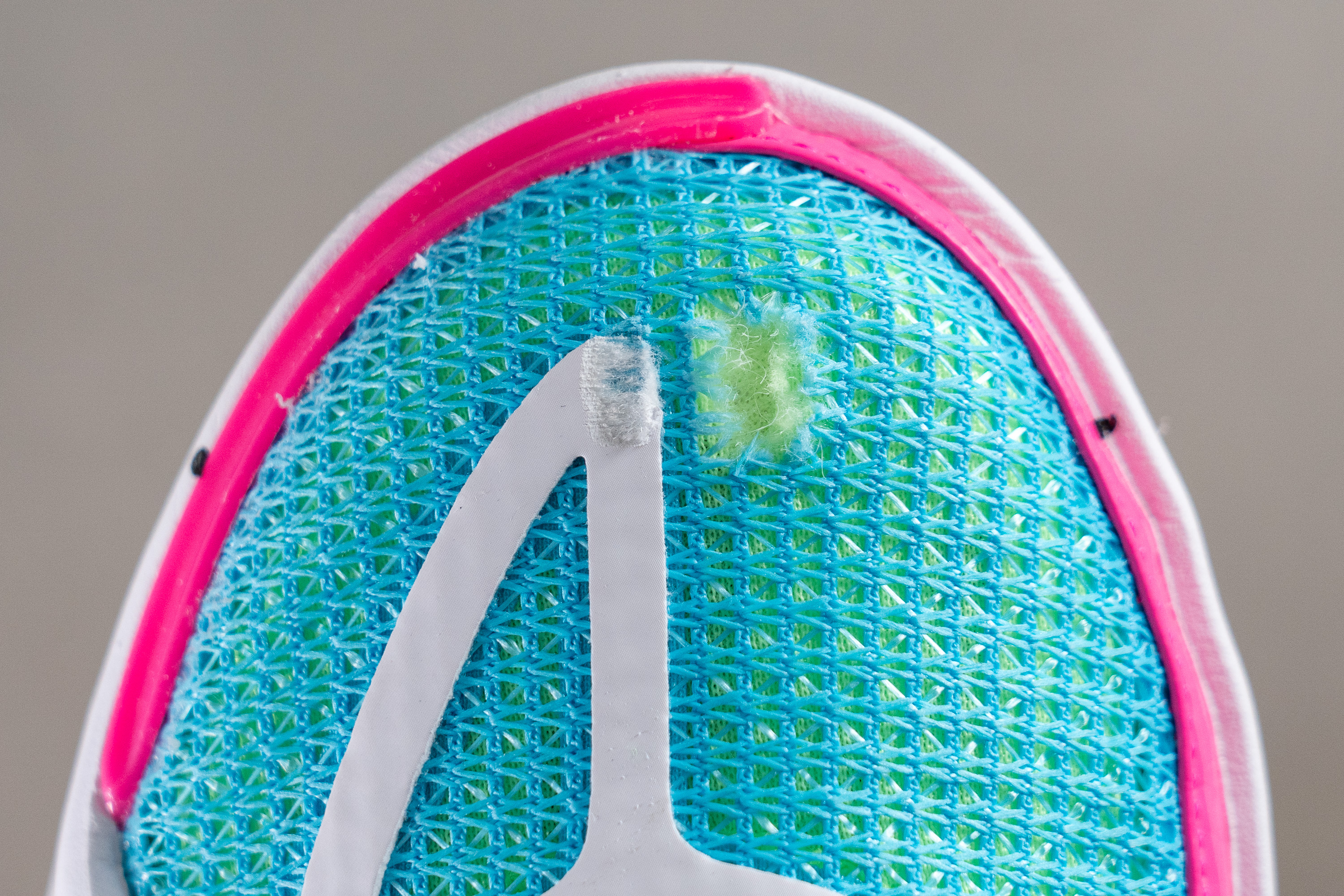
As you can see in the picture, the white layer resisted our tool's attack. But the mesh... got meshed up (so sorry about the joke). Our Dremel obliterated the blue layer, but the green underprotection held up, not letting the tool make a hole.
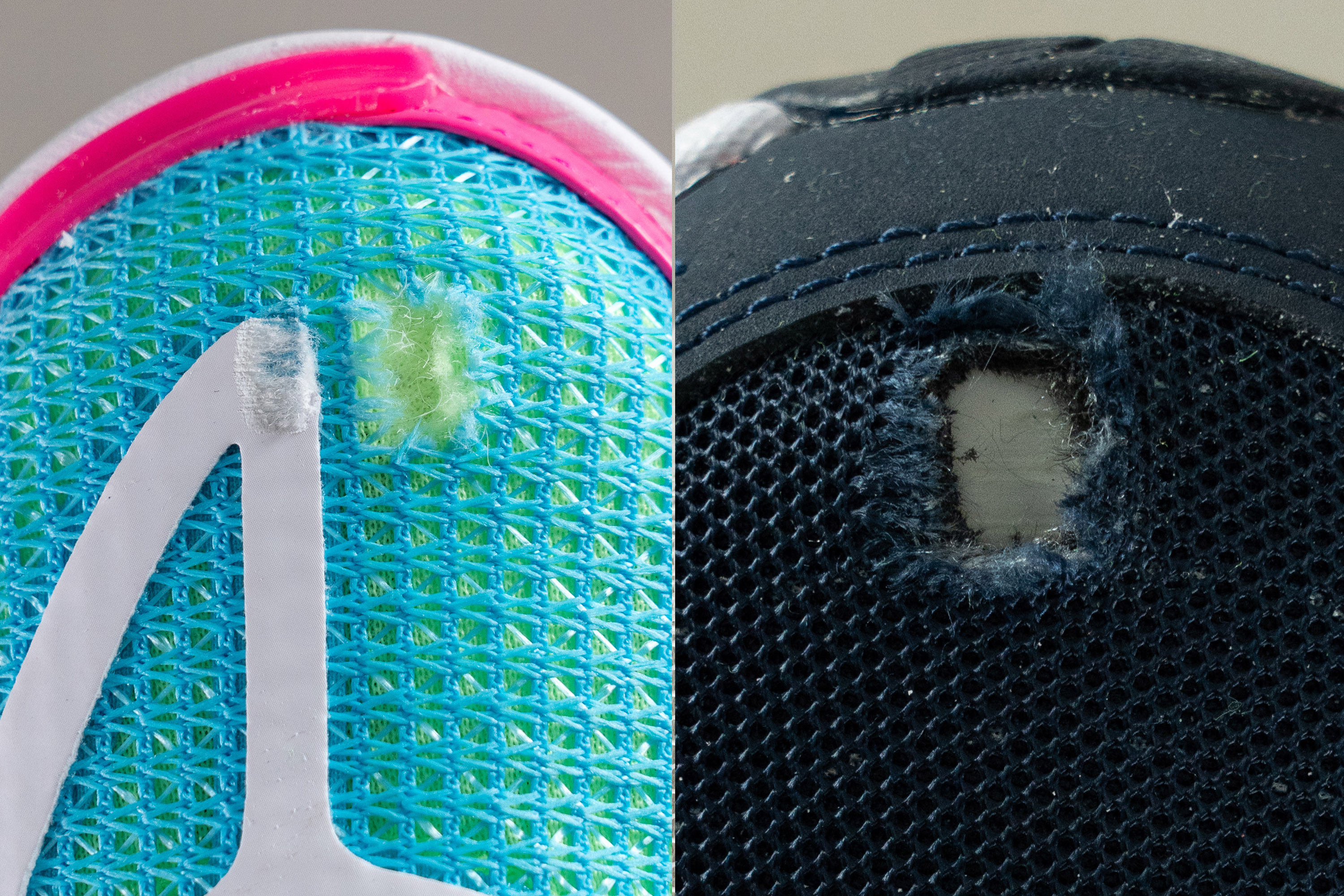
This is what a hole looks like. Hello, Under Armour Charged Assert 10! Our Jordans scored a decent 3/5 in our durability test, but this poor UA pal... couldn't get any more than a 1/5.
| Tatum 1 | 3 |
| Average | 3.7 |
Heel padding durability
If you've ever played or watched basketball, no matter which level or competition, you definitely know just how much and how often players jump. And not only jumps, but dribbles, cuts, explosive moves... All this means there's constant rubbing of your foot and sock against the heel of the shoe you're wearing.
To know more about this, we're going to perform our heel padding durability test. Dremel, once again, we choose you!
These Jordans have us saying: "Not bad, not bad", after every test! Once again, an average score: 3/5. Let's have a look at the shoe's inner lining after our Dremel went all in.
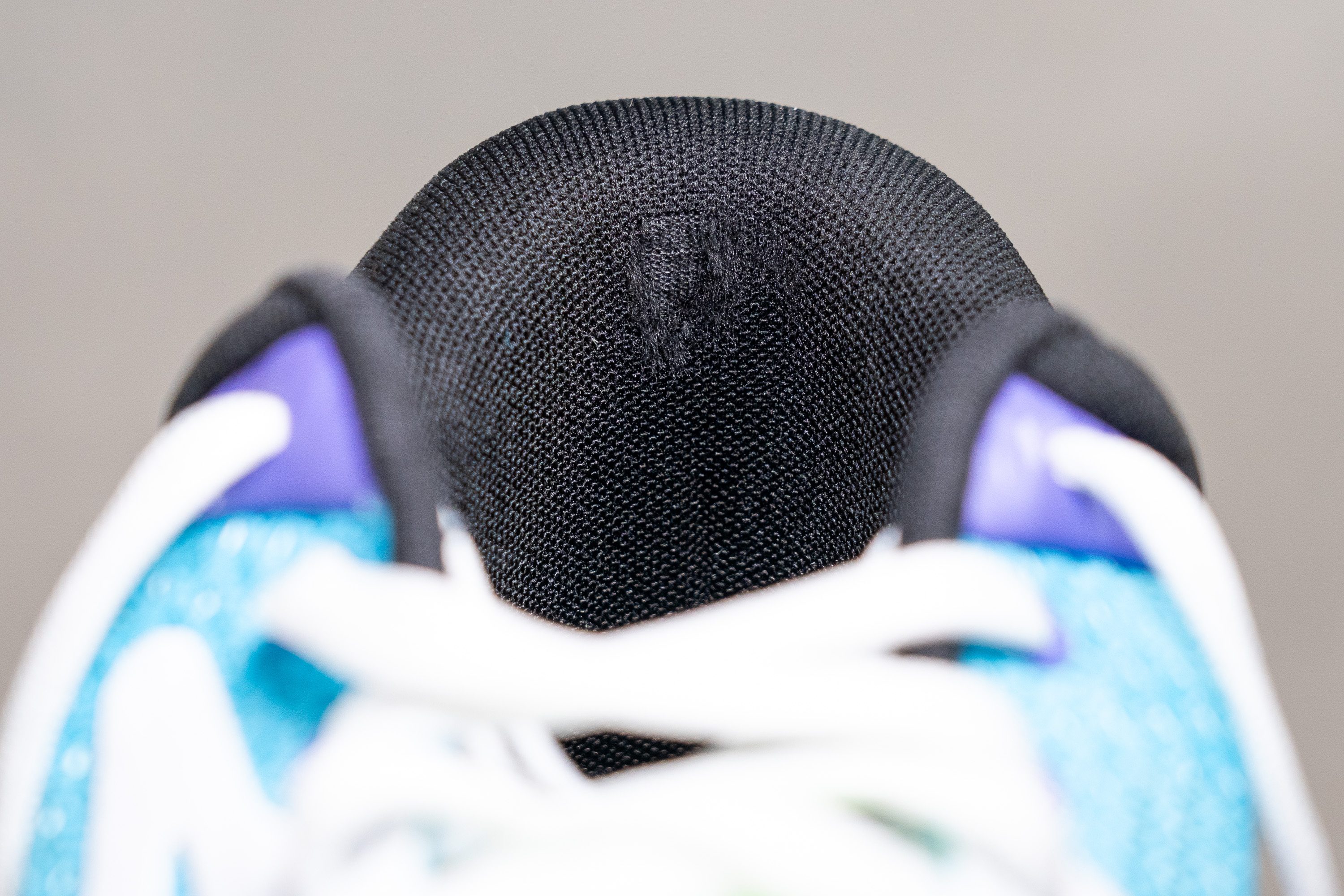
We can clearly see some damage, but not as much as in the UA Charged Assert 9... this one got completely obliterated by our tool.

Now that is scary. It looks like someone just bit it!
| Tatum 1 | 3 |
| Average | 3.7 |
Outsole hardness
Breaking from its "not bad, not bad" status, the Tatum 1 has transformed into "wait, really?" after we checked its outsole hardness. We choose you, durometer!
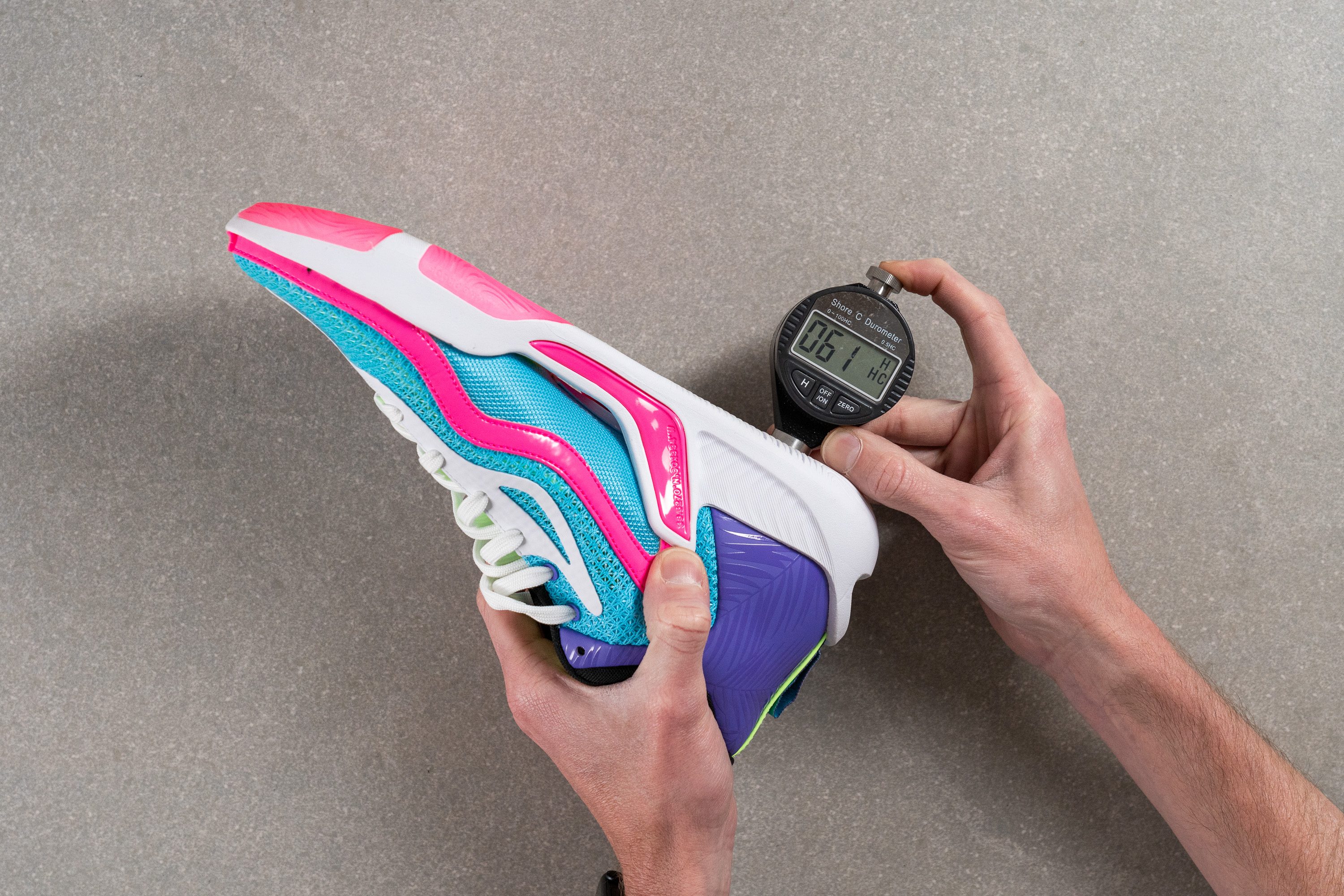
At 61.3 HC, this shoe's score is way lower than average (24% more precisely). Outsoles that get a lower score in hardness are usually less durable but have better traction.
But wait, there's a very important thing that you must know before we move on. We always put our durometer in the same spot, and in the case of this shoe... it'd be measuring the midsole material. As you can see, the pink parts of the outsole are the rubber pods, the ones that will give you better traction. The rest is the material of the midsole (white) working as the outsole.
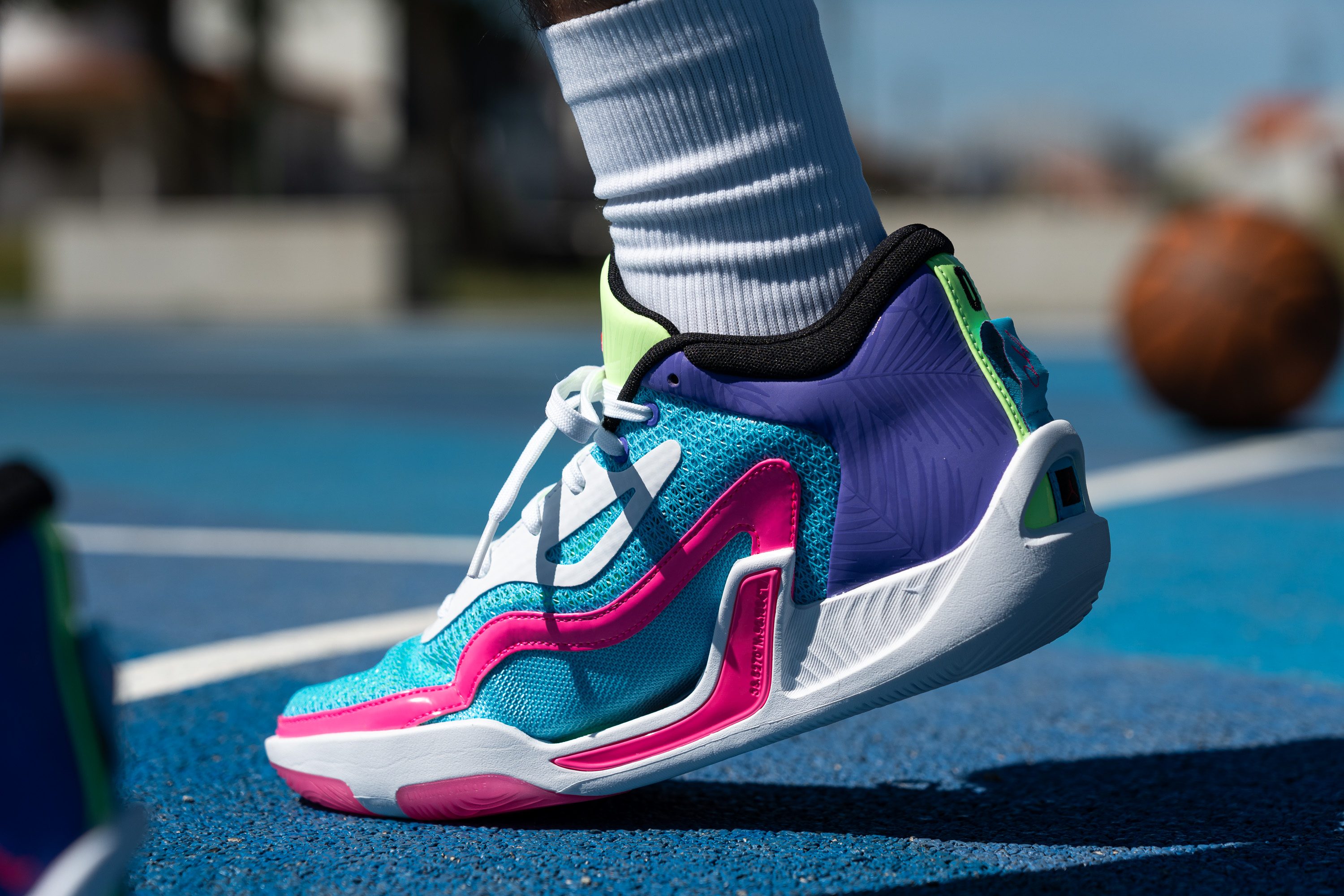
This... isn't gonna have a happy ending regarding durability.
| Tatum 1 | 61.3 HC |
| Average | 81.5 HC |
Outsole durability
As we were saying before, this model is a bit special. If we look at its outsole, we can see there are two different colours: pink and white. The pink parts are the rubber pods, which work on traction, and the white part is an extension of the midsole material.
We grabbed our Dremel again, and after this test we realised how different regarding durability these two outsole pieces are.
The first step of our outsole durability test was done: keep our Dremel rolling on the rubber pods! As you can see, our tool didn't quite damage the material. We were really happy about this, but there was something even better... at 0.4 mm, our gauge told us this wasn't even a scratch! It's an impressive 60% less than average, just wow!
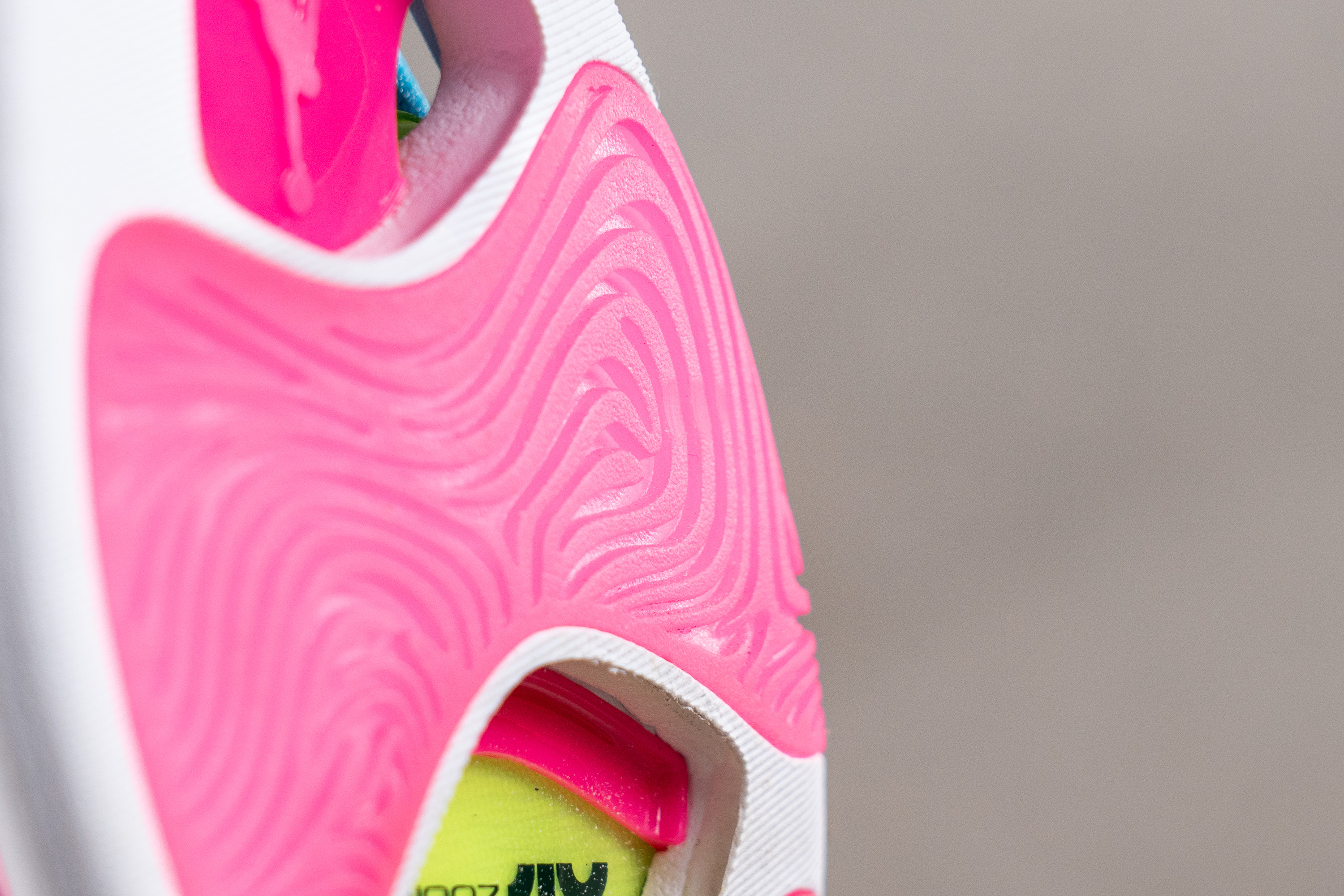
This is what it looks like after the test. Can you even spot where the dent is?
We moved on to test the white part too. After all, most of this shoe's outsole is made of this white material. Even though the pink rubber pods are in the forefoot, the rearfoot doesn't have any of these protective pieces.
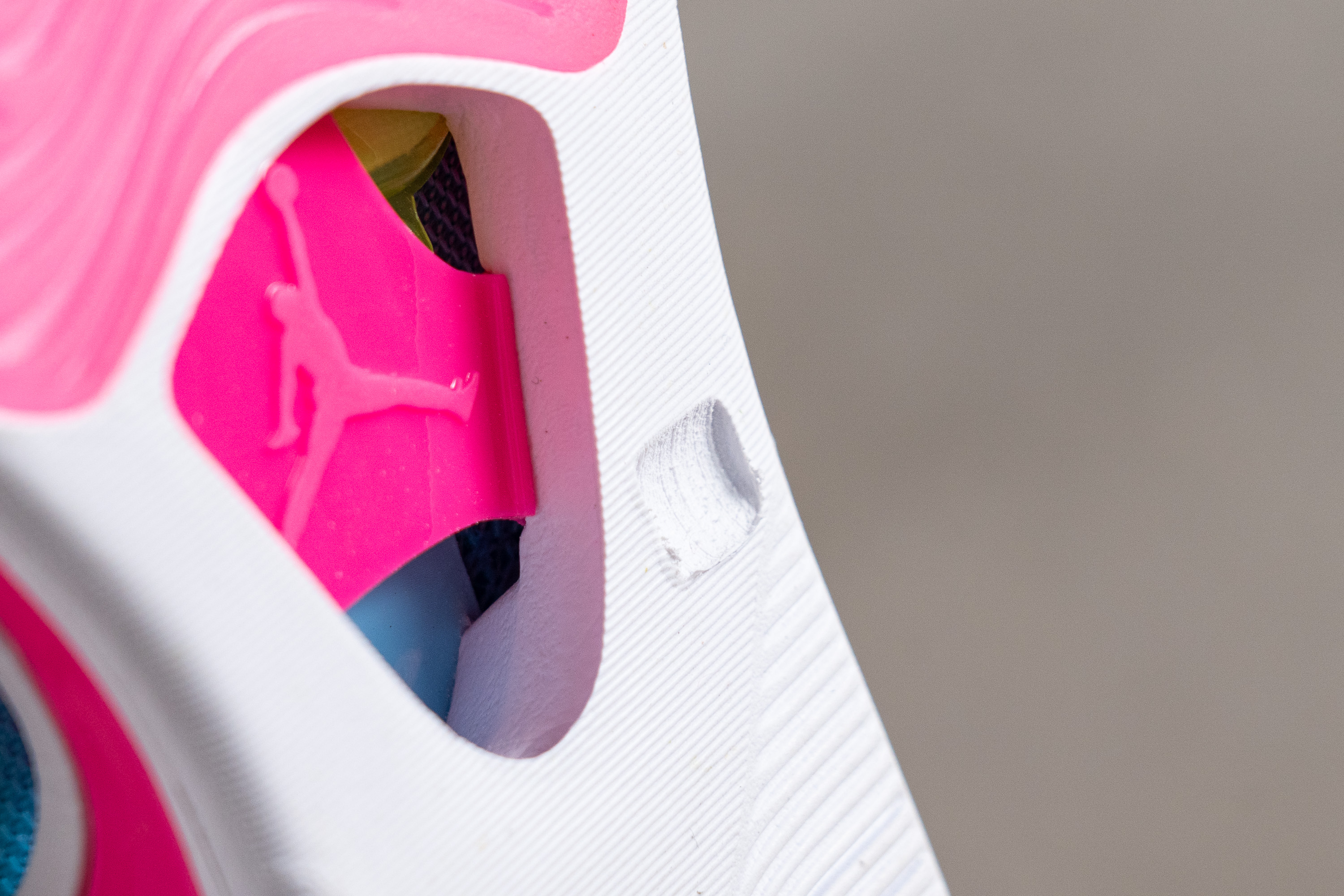
We could already anticipate the lack of durability. Not only because it's a material that is more on the softer side (check the outsole hardness section), but also because of all the debris flying around on our video.
To sum up: do not wear these Jordans outside! Streetball will ruin your them.
| Tatum 1 | 0.4 mm |
| Average | 1.0 mm |
Outsole thickness
As we were saying before, this shoe's outsole has two different parts. To measure its thickness, we grabbed our calliper and went for the pink rubber pods.
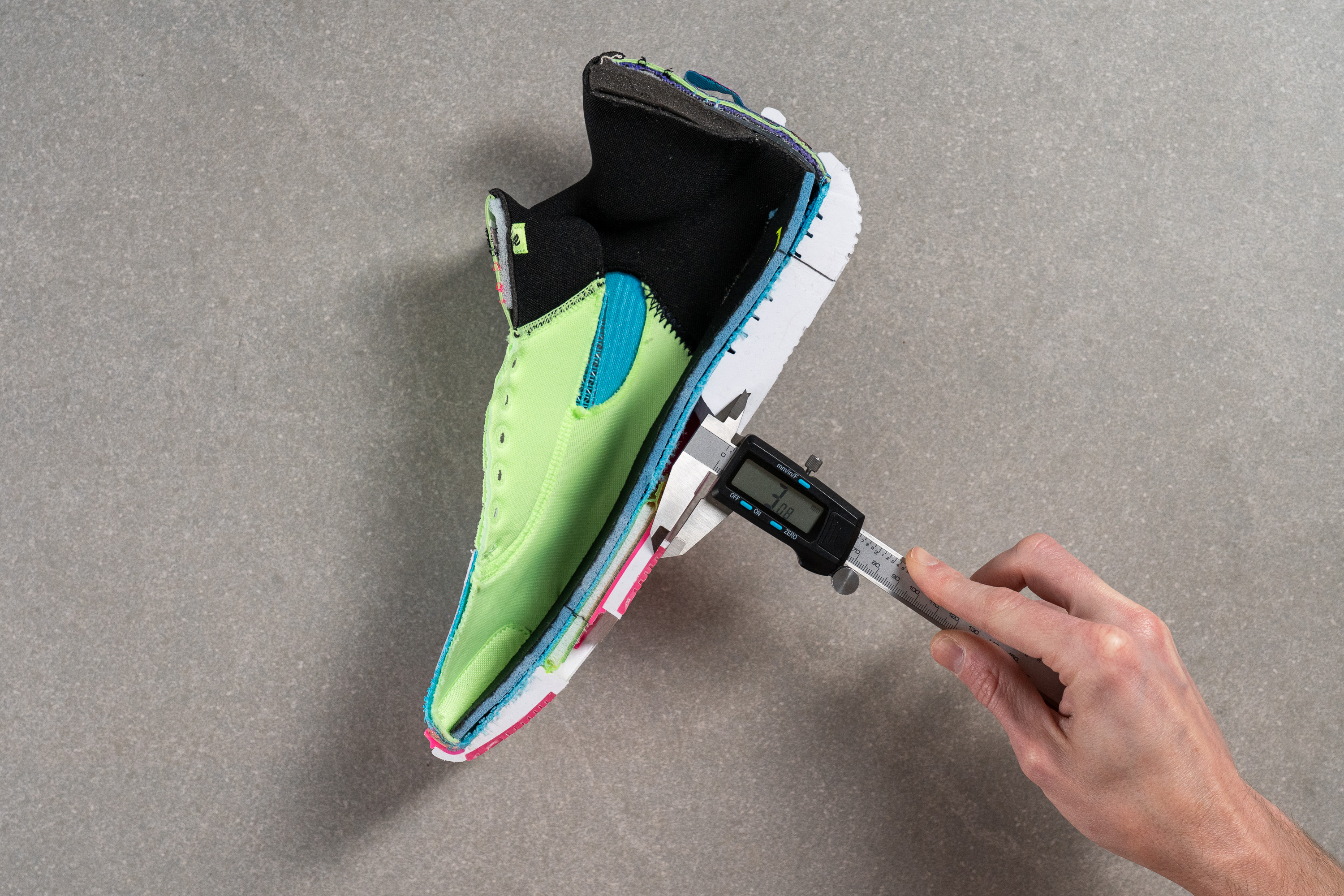
At 3.1 mm, it's thinner than average. But we're not really worried about it. Why? Well, because it showed outstanding durability on our Dremel test!
| Tatum 1 | 3.1 mm |
| Average | 4.0 mm |
Misc
Insole thickness
In order to give us a more comfortable feel, the brand used a thicker-than-average midsole.
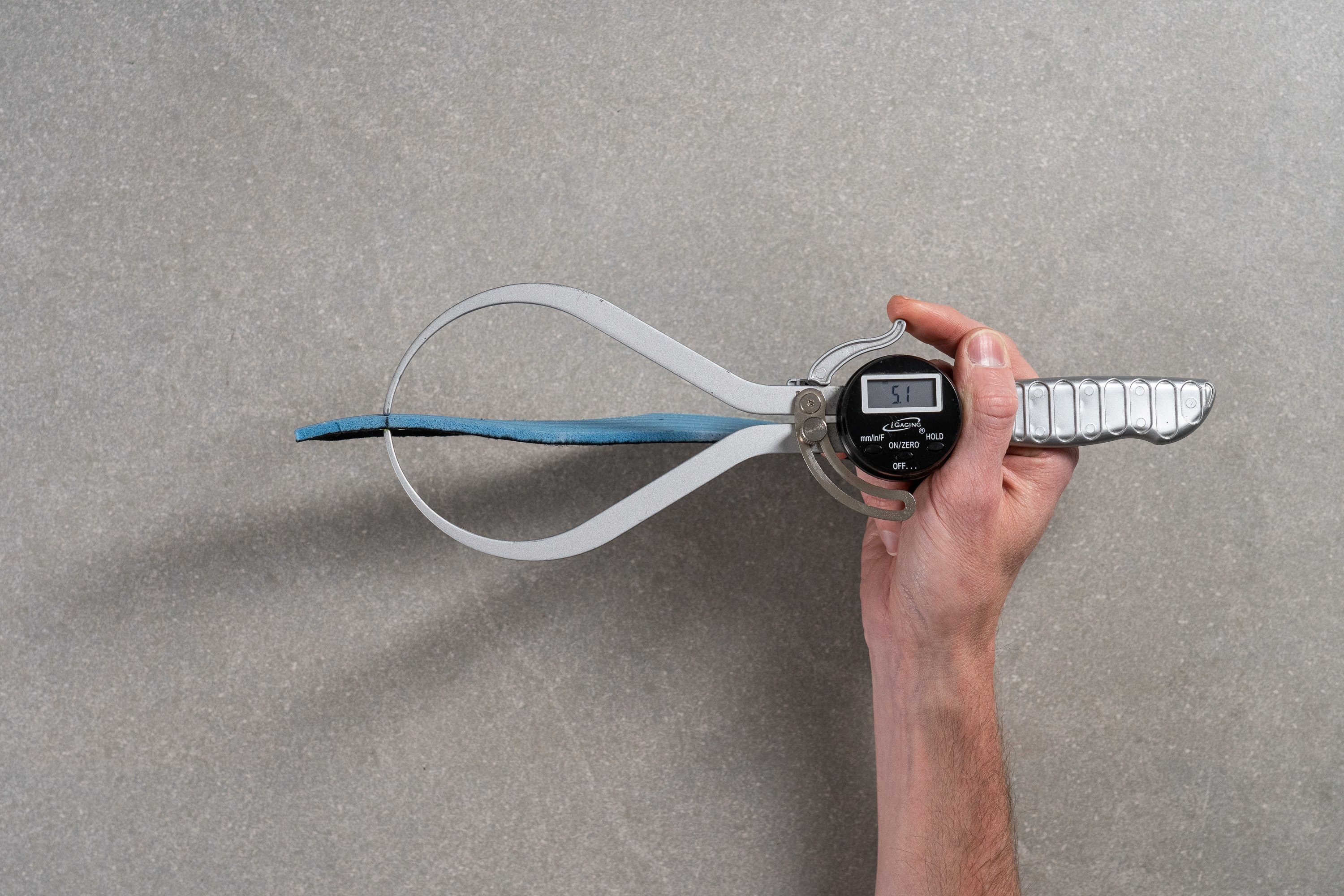
At 5.1 mm according to our calliper, this shoe's insole focused on comfort, which was very much appreciated taking into account the shoe's structure and design.
| Tatum 1 | 5.1 mm |
| Average | 4.9 mm |
Removable insole
We ADORE removable insoles, and these Jordans are here to tell us they are part of the club!
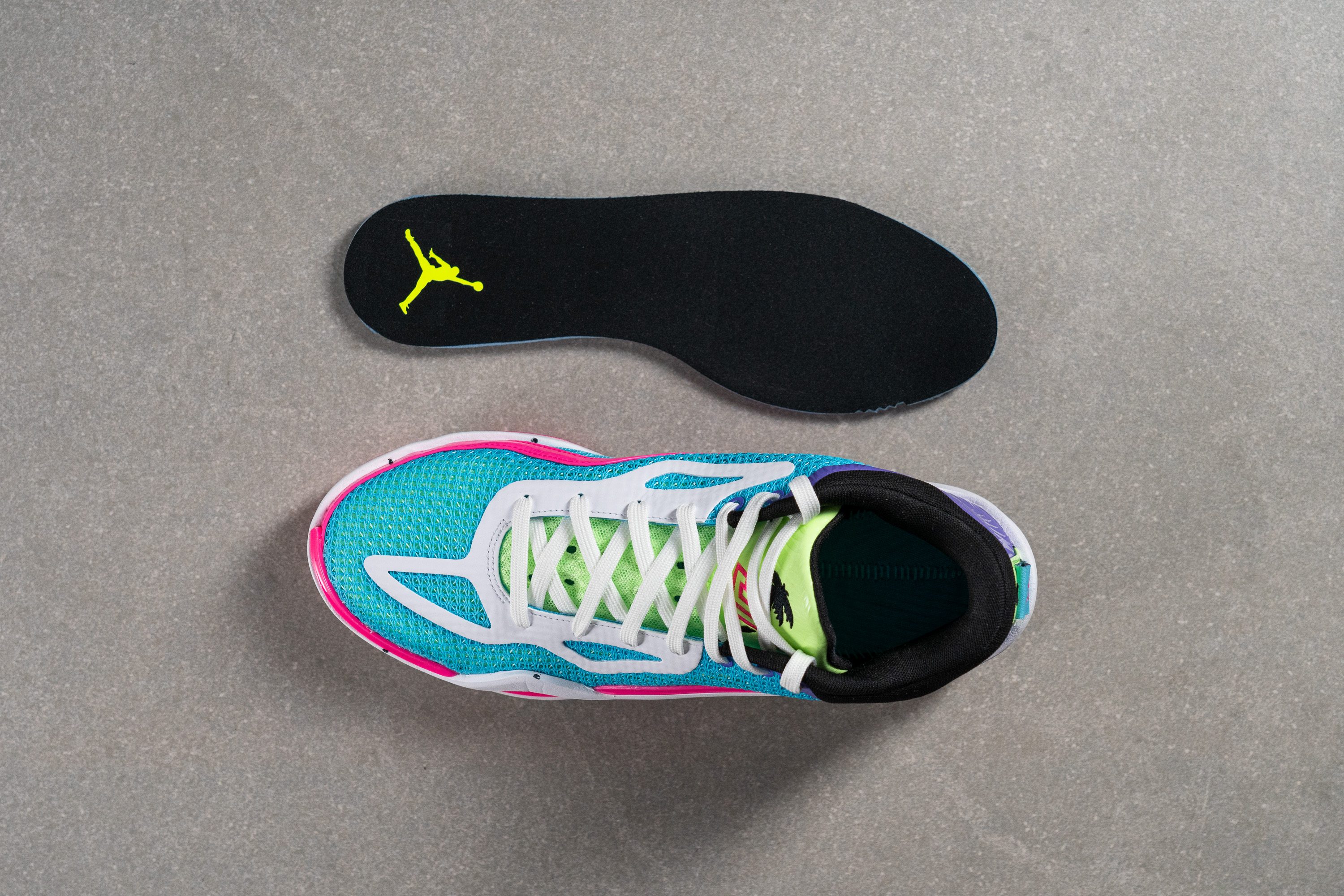
The yellow Jumpman logo made us go absolutely crazy! But that's not the only thing we liked about this shoe's insole. It's pretty thick, but it's great news for us that it can be changed, as this model lacks arch support.
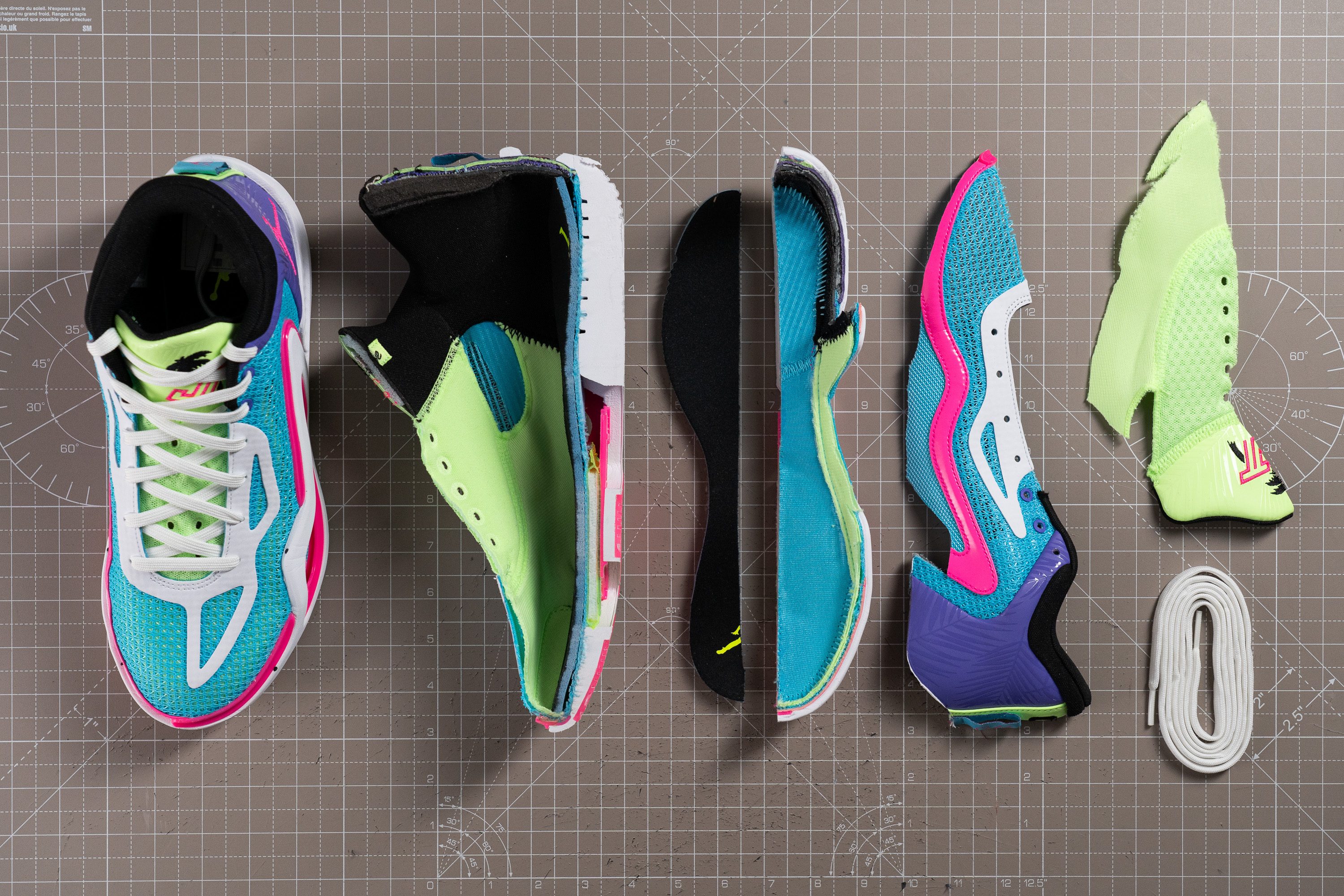
So, if you need your own orthotics or some arch support, you'll have no problems with the Tatum 1.
| Tatum 1 | Yes |
Reflective elements
No reflective elements here, but it's not like we expected them anyway!
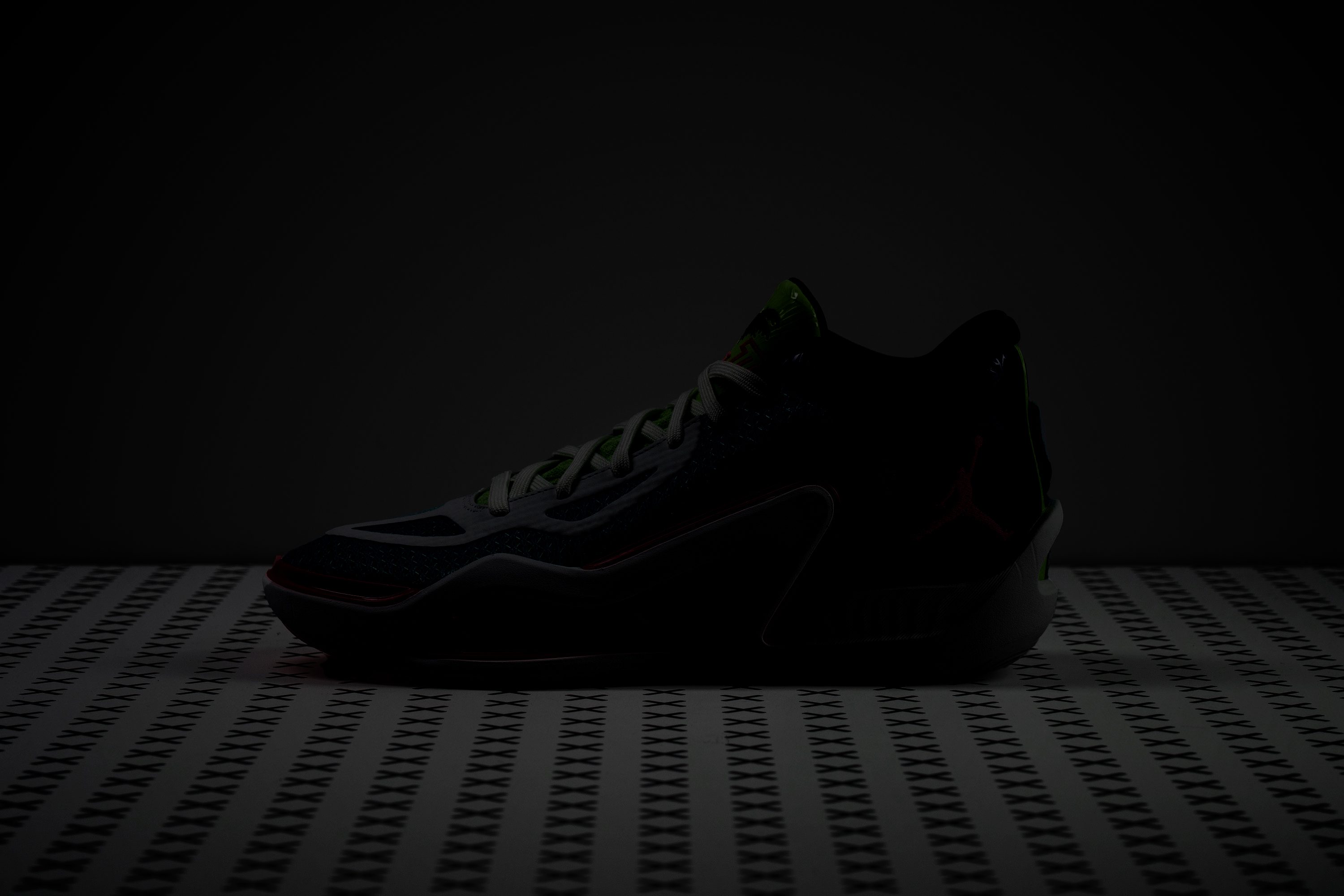
This shoe is NOT made to play streetball with you, so it's not like you'll need some extra visibility. Indoor courts tend to be better illuminated than outdoor ones!
| Tatum 1 | No |
Tongue padding
At 8.0 mm, this Jordan's tongue padding is also not enough to overcome the general lack of foothold. Nevertheless, even though it's thinner than average, the tongue kept us protected from any kind of lace bite.
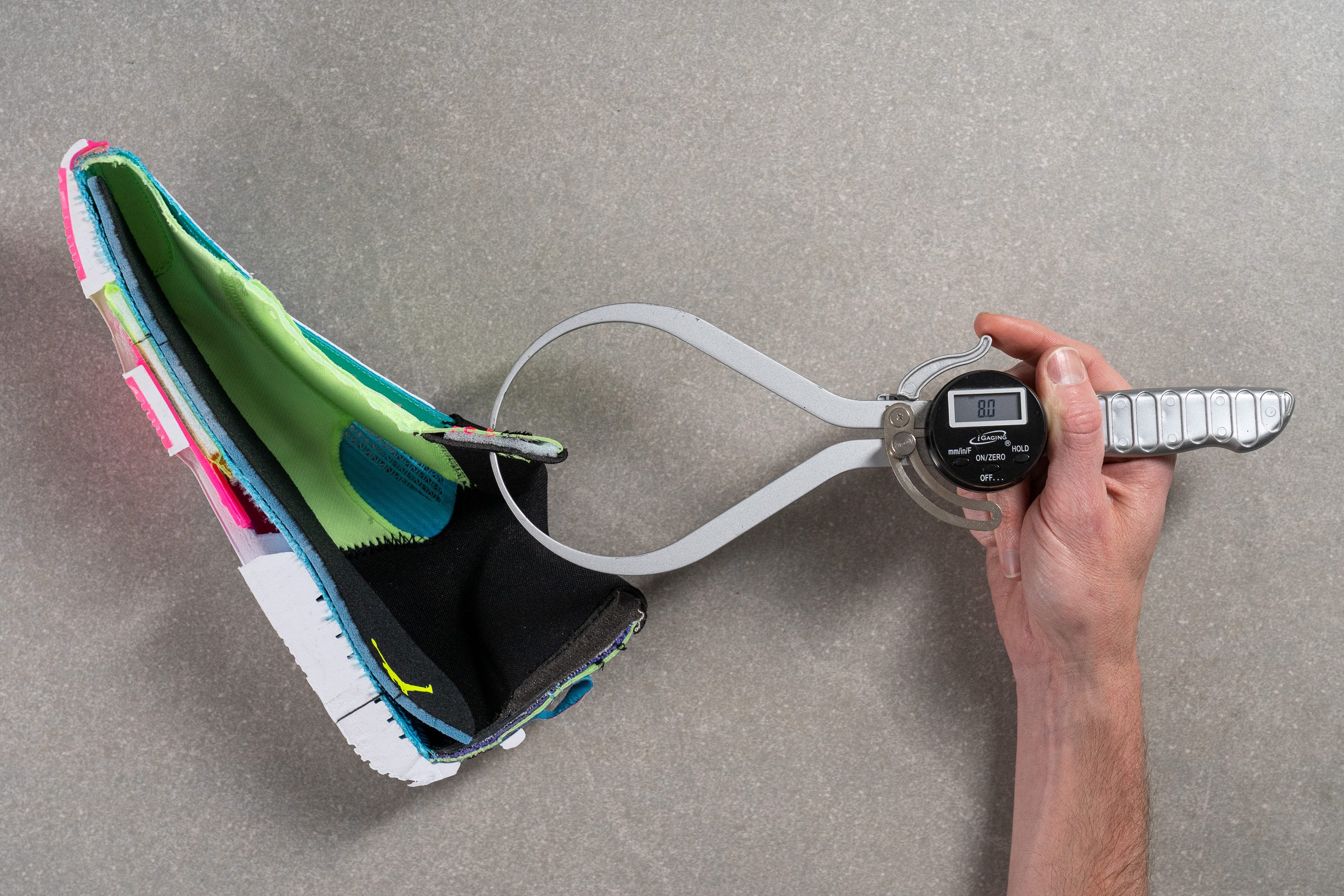
| Tatum 1 | 8.0 mm |
| Average | 9.3 mm |
Tongue: gusset type
The Tatum 1's tongue is fully gusseted. This added some support to the structure, especially in the instep, but it was not enough for us to feel surefooted.
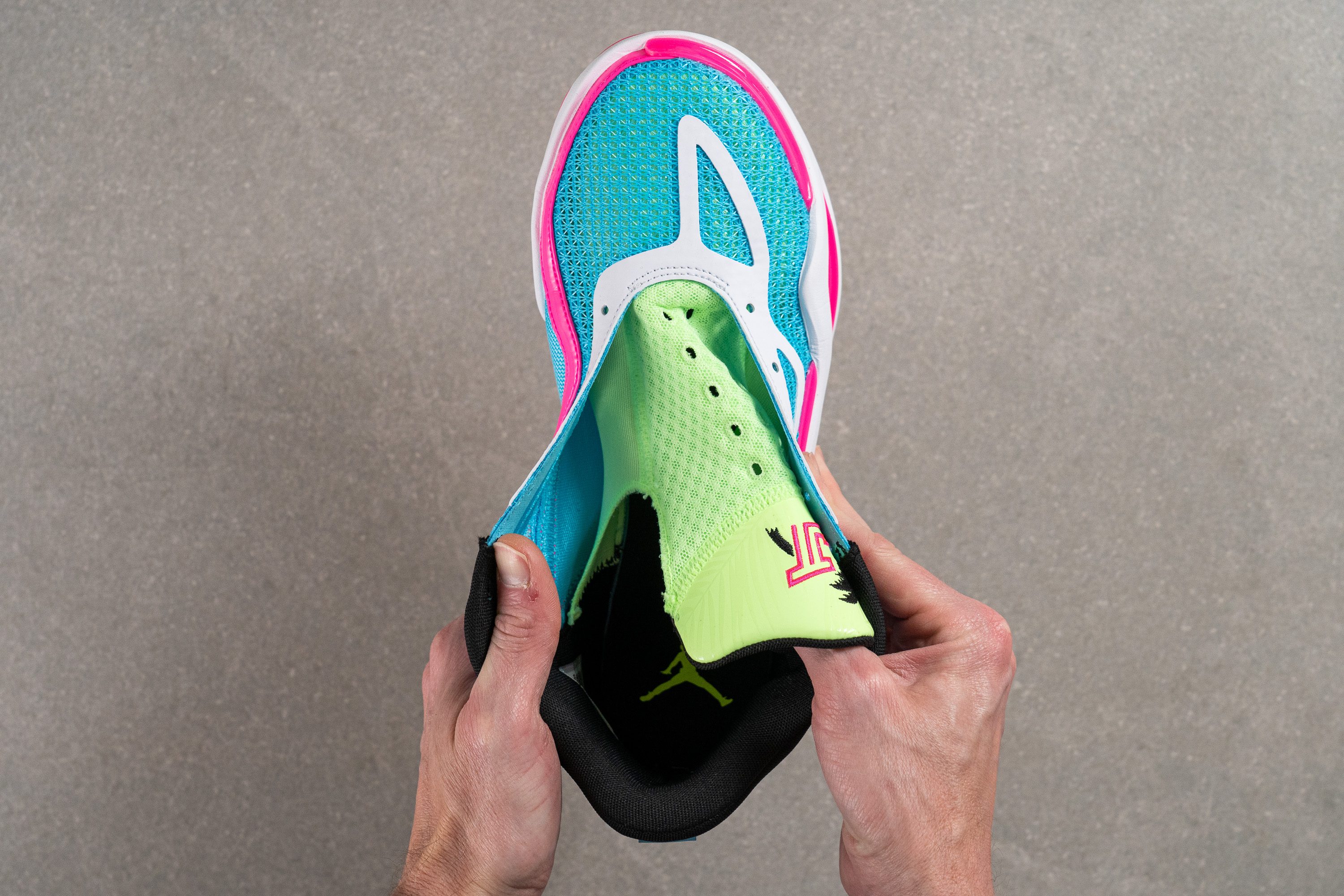
Even though the heel and the tongue do their best to make the structure supportive, it was definitely not enough, as the design itself doesn't focus on this aspect.
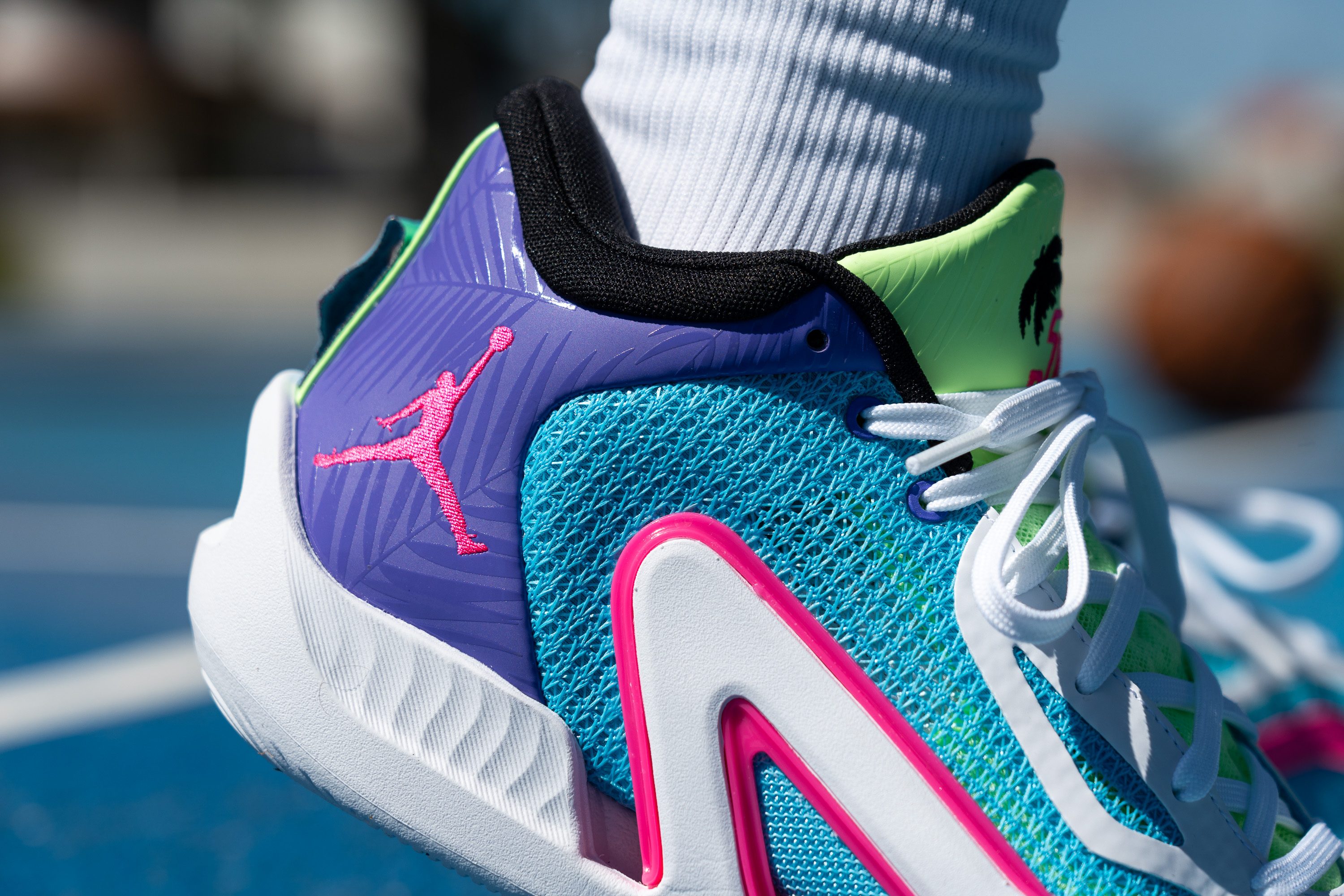
Still, the lacing system did its part. It held this model's flexible profile as much as it could, and we were pretty happy with its performance.
We want to mention that the eyelets in the leather part of the shoe or with a surrounding leather structure made sure we wouldn't rip them apart even if we pulled the laces strongly. Also, this structure has an extra eyelet at the top, which also helped with the overall foothold.
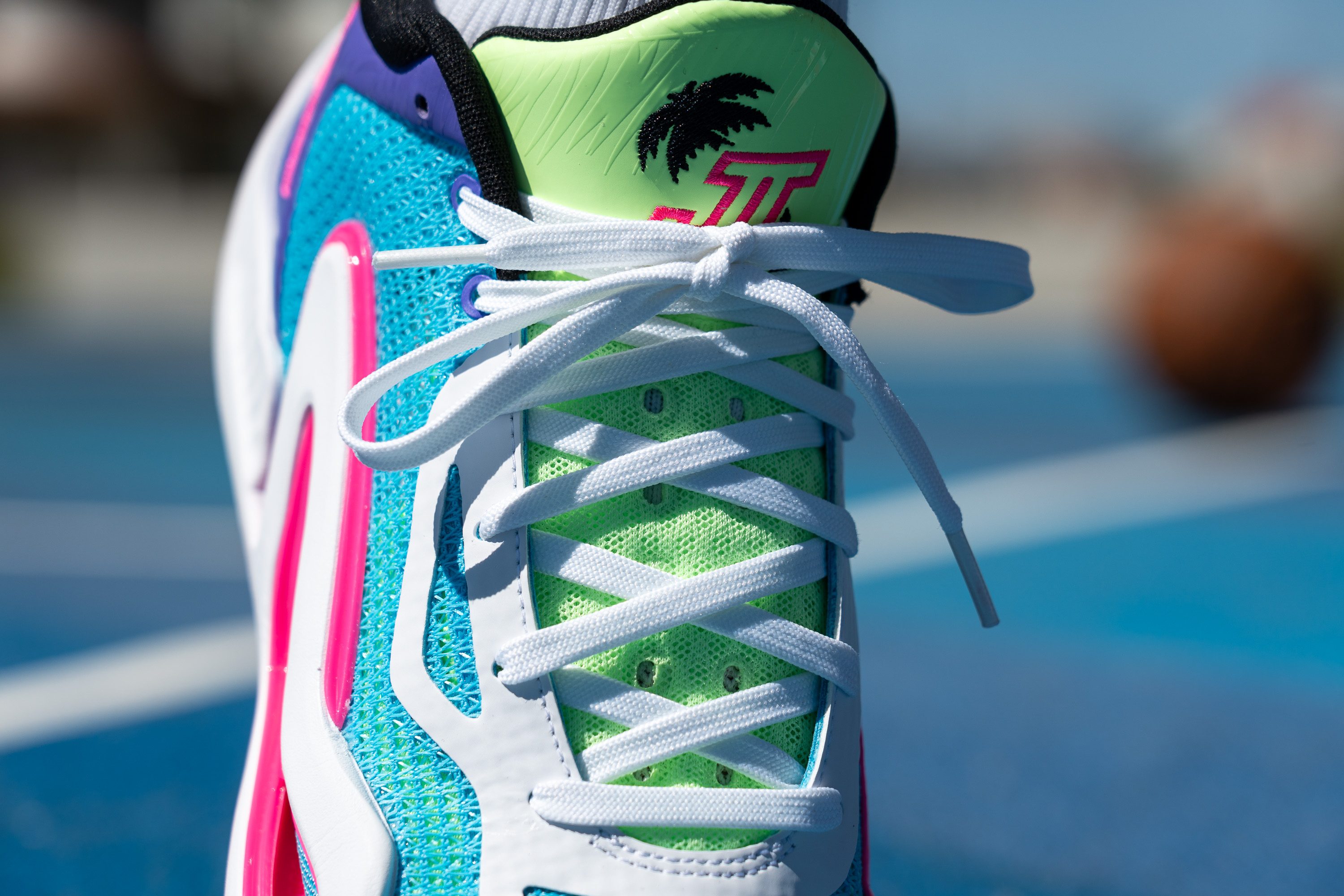
| Tatum 1 | Both sides (full) |
Heel tab
As the yin for its fully gusseted tongue's yan, this shoe has got a finger-loop at the back.
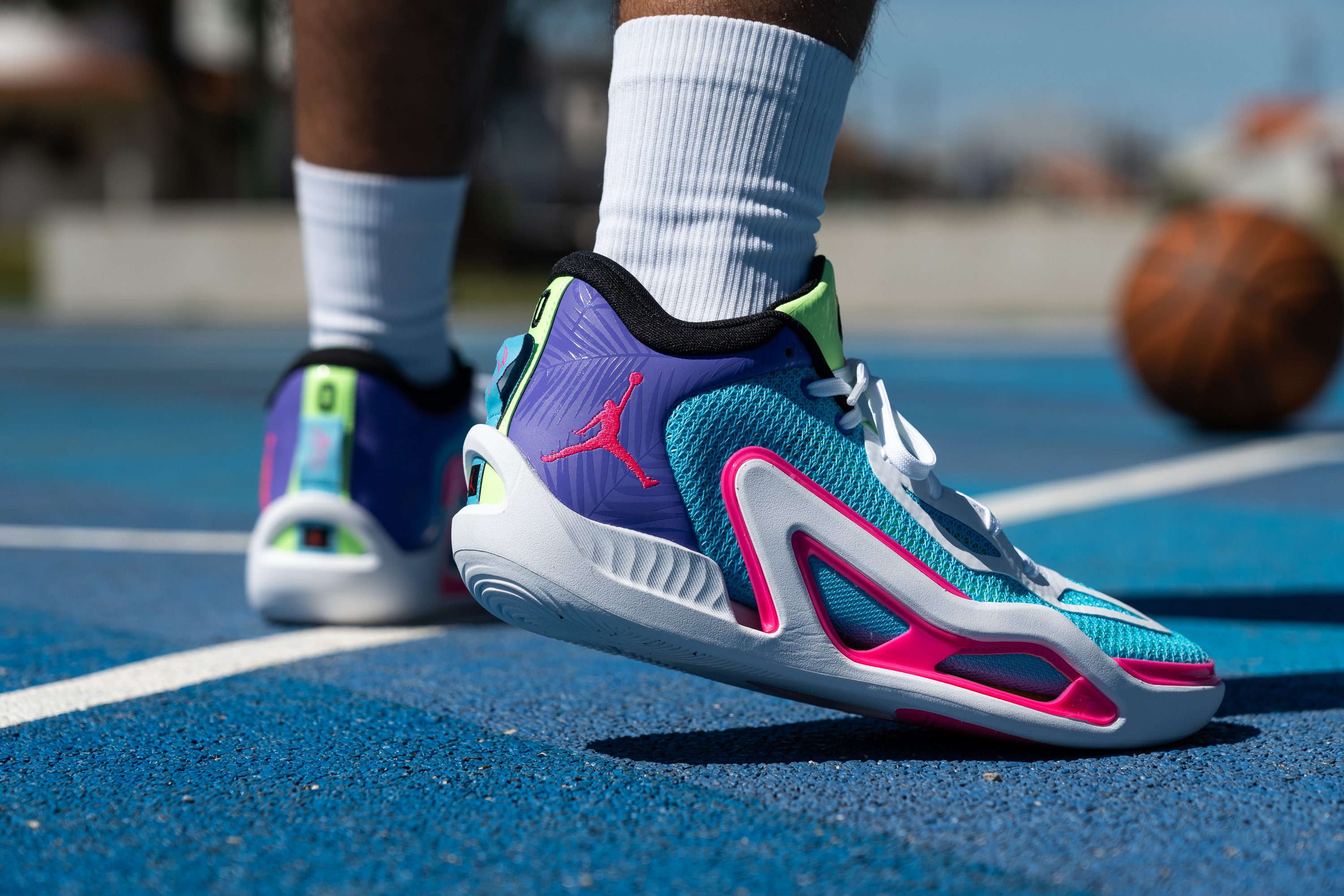
It didn't look or feel very durable to us, but it did its job properly. We also really like how it fits in this model's vibe and colourful structure. Hooping in style, that is!
| Tatum 1 | Finger loop |

